StudyMonkey
Your personal ai tutor.

Learn Smarter, Not Harder with AI
Introducing StudyMonkey, your AI-powered tutor .
StudyMonkey AI can tutor complex homework questions, enhance your essay writing and assess your work—all in seconds.
No more long all-nighters
24/7 solutions to questions you're stumped on and essays you procrastinated on.
No more stress and anxiety
Get all your assignments done with helpful answers in 10 seconds or less.
No more asking friends for help
StudyMonkey is your new smart bestie that will never ghost you.
No more staying after school
AI tutoring is available 24/7, on-demand when you need it most.
AI Tutor for any subject
American college testing (act), anthropology, advanced placement exams (ap exams), arabic language, archaeology, biochemistry, chartered financial analyst (cfa) exam, communications, computer science, certified public accountant (cpa) exam, cultural studies, cyber security, dental admission test (dat), discrete mathematics, earth science, elementary school, entrepreneurship, environmental science, farsi (persian) language, fundamentals of engineering (fe) exam, gender studies, graduate management admission test (gmat), graduate record examination (gre), greek language, hebrew language, high school entrance exam, high school, human geography, human resources, international english language testing system (ielts), information technology, international relations, independent school entrance exam (isee), linear algebra, linguistics, law school admission test (lsat), machine learning, master's degree, medical college admission test (mcat), meteorology, microbiology, middle school, national council licensure examination (nclex), national merit scholarship qualifying test (nmsqt), number theory, organic chemistry, project management professional (pmp), political science, portuguese language, probability, project management, preliminary sat (psat), public policy, public relations, russian language, scholastic assessment test (sat), social sciences, secondary school admission test (ssat), sustainability, swahili language, test of english as a foreign language (toefl), trigonometry, turkish language, united states medical licensing examination (usmle), web development, step-by-step guidance 24/7.
Receive step-by-step guidance & homework help for any homework problem & any subject 24/7
Ask any question
StudyMonkey supports every subject and every level of education from 1st grade to masters level.
Get an answer
StudyMonkey will give you an answer in seconds—multiple choice questions, short answers, and even an essays are supported!
Review your history
See your past questions and answers so you can review for tests and improve your grades.
It's not cheating...
You're just learning smarter than everyone else
How Can StudyMonkey Help You?
Hear from our happy students.
"The AI tutor is available 24/7, making it a convenient and accessible resource for students who need help with their homework at any time."
"Overall, StudyMonkey is an excellent tool for students looking to improve their understanding of homework topics and boost their academic success."
Upgrade to StudyMonkey Premium!
Why not upgrade to StudyMonkey Premium and get access to all features?
Writing: Get your essay and assignment written from scratch by PhD expert
Rewriting: Paraphrase or rewrite your friend's essay with similar meaning at reduced cost
Editing: Proofread your work by experts and improve grade at Lowest cost
Enter phone no. to receive critical updates and urgent messages !
Error goes here
Please upload all relevant files for quick & complete assistance.
New User? Start here.
MyAssignmentHelp #1 Assignment Writing Service
Need assistance with your assignments? Help is on the way!
The Best Assignment Writers

How Our Online Assignment Help Services Work?
Fill Order Form
Pay for Services
Receive the Solution
MyAssignmentHelp: Top Assignment Help Features
Our assignment writing service has helped thousands of students improve their grades. We guarantee the highest quality writing at all times.
Every assignment writer on our website has completed their Master’s or Doctorate degree. Rely on them for all types of academic assistance.
If you need assignments on time, we are the best option for you. Beat impossible deadlines with our 24-hour delivery for urgent papers.
We always ensure to provide affordable services through our dynamic pricing system. Make the most use of our discounts and bonuses.
Our student-friendly policies include a money-back guarantee. Rest assured that we’ll take responsibility for all papers.
Feel free to get in touch with our academic writers whenever you want. Send in your queries, and they'll get back to you ASAP.
High-Quality Assignment Assistance For All Assignment Types
Get excellent writing help from reputed writers in the US.
Writing an essay assignment becomes a piece of cake when you can hire our scholars to assist you with the task. These professionals can help you choose an essay topic, compose the outline, and conduct research.
Homework Help
Our assignment help service provider is renowned across the country for assisting students with all kinds of homework. That’s because MyAssignmentHelp hires the best scholars from every academic field imaginable.
Dissertation Help
Our dissertation writing service can make all your writing troubles disappear. Hiring our assignment help experts means you get excellent dissertation proposals, literature reviews, data collection, and writing guidance.
Coursework Help
Rely on our assignment help experts when your coursework becomes too much to handle. These professionals can assist you with topic selection, editing and proofreading, and more so you can improve your grades.
What Students Say About MyAssignmentHelp
Glimpse into what thousands of students have experienced.
Essay: 2 Pages, Deadline: 2 days
thank you for your support, it was a great pleasure to work with you and my assignment was done in very professional way. thank you again
Assignment: 10 Pages, Deadline: 2 days
i am very happy with my assignment; everything is well written. I cant wait for my grade .
Thesis: 1.2 Pages, Deadline: 2 days
they follow all of my request. my solution was ready on time. so far, I have a great experience with them.
Home Work: 2 Pages, Deadline: 3 days
everything looked great, instructions were followed, the work was really clean and clear. thank you
Essay: 1 Page, Deadline: 5 days
I have great graditude towards my Expert and the accomplishment that has allowed me to pass this assignment. I received an A. I would like to say t ...
Essay: 2 Pages, Deadline: 3 days
Fast communication great work high scores guaranteed…. Not a scam free from AI .
Programming: 1 Page, Deadline: 7 hours
hi i need some changes how i can add file for you as reference please contact asap
Assignment: 1.6 Pages, Deadline: 3 days
This is very helpful for me especially as a busy mom in school and having to juggle a lot .. you guys are definitely the BESST n
Home Work: 1.2 Pages, Deadline: 1 day
they gave me my work on time. they follow all requirements. I am very satisfied. Hey, do a good job.
Assignment: 1 Page, Deadline: 1 day
it was very good, I had a goos grade, and the teacher really liked the idea of slides
Case Study: 4 Pages, Deadline: 4 days
it was really good. it helps me write the project. i would use them again. thankyou
Assignment: 2 Pages, Deadline: 2 days
It is a very good resource to solve the problem and get assignment help. I would like to strongly recommend this site to all viewers.
Assignment: 2 Pages, Deadline: 4 days
Thank you for the impromptu support and help for the amazing report in just couple of hours. I am glad I have come across this help page for assignmen ...
Essay: 4 Pages, Deadline: 5 days
86 percent attained, assignment returned on time, well organized and composed. ni hope future submissions are this focused
Essay: 1 Page, Deadline: 3 days
Thank you! I am at the top of my class and it feels great. The grades have been outstading and has helped me pass once again.
Programming: 18 Pages, Deadline: 3 days
very good one. absoulutely loved the work from the tutor. i love the one who did the assignment. Big Thanks
Home Work: 10.5 Pages, Deadline: 6 days
got lot's of time to get done but it was a good work with good ponts numbered pages with right line spacing
My last minute assignment was completed right on time … and i got 90% on it thanks guys n
Programming: 4 Pages, Deadline: 8 days
detail, thorough analysis, and creative approach were truly impressive , which shows understanding of the subject matter
Home Work: 2 Pages, Deadline: 1 day
like all my other assignments this one was also very well written a very good. Had a good grade.
Quality Assignment Writing Services at Affordable Prices
- Mathematics
Assignment Help & Writing Tools
Discover our collection of high-end academic tools for A+ writing.
Plagiarism Checker
Submit plagiarism-free work with our AI plagiarism-checking tool. Unique solutions are guaranteed.
Paraphrase Tool
Avoid the hassle of rewriting your entire paper by using our paraphrase tool for quick solutions.
Spell Checker
Don’t let incorrect spellings keep you from top grades. Try our spell checker for perfect writing!
Grammar Checker
Leave your worries about grammatical errors behind by making the most of our grammar checker.
Word Counter
Keep track of your task's length with accurate word count, paragraph count, page count, and more.
Resume Builder
Impress all working professionals with a custom-built resume generated from our resume builder.
Equation Solver
Solve all complex mathematical equations in the blink of an eye thanks to our equation solver.
Other Tools
Try out our other free tools like citation generators, essay typer, PDF summarizer, and more.
Online Assignment Help for Busy Students
There’s a common misconception that students book professionals for college assignments when they’re too lazy to work on the papers themselves. But that’s not why the majority of students seek assignment help! In fact, it’s the complete opposite. Almost every student who wonders, “I wish someone could do my assignment for me,” does so because they barely have any time to spare. That’s because most of their time goes into –
- Attending college or university classes
- Participating in extracurricular activities
- Working part-time for financial support
That’s why our university assignment help service exerts a lot of effort into making sure you don’t waste a precious second. Here’s what we offer –
Hassle-free registration
The sign-up process on our website is very simple. All you have to do is fill out the details. There’s also a handsome registration bonus.
Quick order placement
When you need help with assignment writing, place an order on our website. You barely spend a few seconds on this task.
Instant assistance
We assign an assignment helper to your task ASAP, so you don't have to waste a second waiting for an expert to become available.
Smooth customer support
Our support team makes sure to solve all complaints by customers in record time. That's why students rely on us for online assignment help.
Get Instant Help
Advantages of Online Assignment Help
There are plenty of reasons why students look for websites where assignment helpers write essays for money . The advantages they provide can make all your writing problems disappear. Let’s check out what you can expect from our online assignment help service.
Writing assignments become 10x easier when you know you can already hire a college assignment helper for guidance. Shove all your worries about poor grades, overall writing quality, and tight deadlines at the back of your mind. That’s because these experts take care of those details. For example, when you hire our custom essay writing services, you are guaranteed the following –
- Well-researched essays
- Error-free content
- Plagiarism-free work
It’s clear why getting online assignment help is the trend nowadays. After all, an assignment written by one of our experts is bound to meet the high standards that your professors expect from you.
Choose An Expert
Why Students Need Online Assignment Writing Services
The need for professional writing assistance has increased exponentially in recent years. According to experts, almost 1 in every 3 students wonder, “I wish I could pay someone to do my homework .” Thankfully, we’re always available to resolve all your problems. But first, let’s figure out why students need to rely on homework assignment help websites in the first place.
Meet Tight Deadlines
When you have to avoid late-submission penalties, assignment help writers are your saving grace. Our professionals can help you submit your assignments on time without compromising the writing quality.
Improve Writing Quality
An assignment expert with exceptional writing skills can write research papers or dissertations with no errors. Their guidance can help you avoid losing grades due to poor writing quality.
Well-Researched Papers
Our assignments play a huge role in helping you compose well-researched papers. They are written after our experts conduct in-depth research from reliable sources. Review them to improve your writing quality.
Plagiarism-Free Writing
The academic writers on our team compose every assignment from scratch so they can improve the academic performance of our customers. Students can forget about plagiarism issues when they book an assignment online from us.
When you need guidance with a particular subject for higher grades, our assignments help you at every turn. Review them to improve your knowledge and research skills.
Book Our Services
Assignment Services For Various Academic Areas
If you’re looking for a reliable yet cheap assignment help website where you can buy coursework online , we’re the best option you have. After all, we’re considered the top assignment help service because our professional writers cover all aspects of academic writing. In other words, hiring our assignment service means all your academic areas are covered –
Guidance in 100+ Subjects
We’re one of the best online assignment help websites where you can get assistance in 100+ subjects, including medicine, literature, law, agriculture, psychology, etc. Tell us, “Do my assignment” for whichever subject you pursue.
Help with all Academic Levels
Even if you’re in school or studying at one of the top universities in the US, our services will come to your rescue. We help students of all academic levels.
Editing & Proofreading Assistance
After writing assignments, we always edit and proofread them to perfection. This is part of the add-on services that our company provides.
All Degree Levels Covered
Students pursuing Master’s or Doctorate degrees from top universities in the US are welcome to book our services. Our assignment writing service provides high-quality guidance.
As evident from the points covered, we provide the best assignment help USA has to offer for all kinds of academic tasks. That’s why we are one of the top professional assignment help services that promise good grades in every academic field.
Top Grades As A Result Of Best Assignment Writers’ Work
Students usually wonder, “I wish someone could write my assignment", when they are in desperate need of high grades. Fortunately, our professional writers have years of experience in academic writing and can whip up perfect assignments in no time. Whether you need help with a research paper or can’t figure out how to go about essay writing, the assignment expert assigned to your task will lend you a helping hand. Here’s what you can expect when you hire us for help with assignment writing:
Unique Assignment Topic Choice
Hiring a professional assignment expert means you can write unique papers. Their experience allows them to view common topics from a unique perspective.
Researched from Reliable Sources
Our online assignment helper has access to several reliable academic sources, such as journals and archives. That’s why you always get top-quality content.
Completely Error-Free Writing
You need not worry about the quality of your essay assignments anymore. Our online assignment help service guarantees zero errors.
High-Standard Assignments Guaranteed
All homework assignments that we deliver, whether for school or university, are always up to the highest standards. We do not compromise in that regard.
Our company takes every measure possible to help students improve their knowledge and achieve academic excellence. So, you can expect good grades when you book our writing services.
Affordable Assignment Help
Students looking for help with assignment writing in school, college, or university can't really splurge on such online writing services. That’s why we don’t take unreasonable charges for custom essay writing or other assignment help services. Instead, we offer affordable paper writing services through the following means:
Registration Discounts
When you need assignment writing help and register your account on our website, you can unlock a registration bonus. Use this on your first order to unlock unbelievable prices.
Exciting Offers
Our year-round discounts help you fulfill all your academic needs and make your academic life easier without making you go broke. You’ll find a lot of exciting offers on our website.
Referral Bonuses
You can accumulate referral bonuses when you recommend our assignment experts to your friends and peers. When they need help with assignment papers and hire us, you can get discounts on your tasks.
Dynamic Pricing
Our university assignment help online service offers dynamic pricing. In other words, you pay only for the services you choose. We review multiple factors to provide you with the best pricing.
The path to achieving academic success might be riddled with hurdles. Fortunately, our reasonable pricing means you don’t have to spend all your savings getting assignment help from expensive writing companies.
Get a Quote
Will You Do My Assignment Right Now?
Whether you’re struggling to deliver assignments on time or need guidance with a particular subject, feel free to get assignment help online from us. Our assignment experts are available 24/7 to provide writing help in every subject, such as the following:
Here’s how you can book online homework help from us:
Share Your Details
Whether you need essay assignment guidance or dissertation writing assistance, all you have to do is share the task details. Add details like the submission deadline, referencing details, task length, etc. We’ll customize the perfect solution for you.
Make the Payment
Once our service provider reviews your task details, we provide you with a tentative charge. This is the bare minimum we charge in order to compensate your assignment expert for the time they spend on research and writing the assignment.
Get the Solution
We always submit assignments before the deadline. You can stay up-to-date on the progress of your task by getting in touch with the expert yourself. Once the writing is complete, we’ll send you a notification. Log in to your account to access it.
Teachers at most universities seek high-quality assignments. Fortunately, when you seek writing help from us, we ensure that the assignments you submit exhibit in-depth knowledge on the topic.
Will My Assignment Help Do My Assignments for All Genres?
MyAssignmentHelp is the #1 service provider in the US that makes the learning process easier with high-quality assignments. The writers use their excellent analytical skills to craft outstanding solutions that will leave all your professors impressed. Additionally, when you opt for our services to get help with assignment papers, you can look forward to assignment assistance in almost every type of academic work, such as the following:
- Research papers
- Case studies
- Dissertations
- PPT presentations
- Literature review
- Journal writing
- Opinion pieces
- Book reviews
When you book an assignment online from us, we make sure that the solutions we offer can help you improve your knowledge. We don’t repeat the same ideas again and again. Instead, our experts at MyAssignmentHelp try their best to present unique ideas. They leave no stone unturned when searching for research gaps. That's why academic writing becomes easier when you hire our experts.
Even if you have poor time management skills, we’re there to lend you a helping hand. We understand that some papers take more time than others. That’s why, when you choose us for assignment help online, we promise that you won’t have to worry about time at all. Our writers’ excellent writing skills and in-depth knowledge of all topics allow them to complete all work in record time.
Connect to Experts
Frequently Asked Questions
Is your assignment help service legal.
We have been guiding students for over a decade. Out of all online assignment help services that you find online, ours is the most legitimate. You can go through our student testimonials to check their experience. We offer reliable academic support, so you don't have to worry about your assignments. Discretion is our middle name. Once you place your order with us, we maintain complete confidentiality. You won’t find a more legitimate service than ours.
Can I choose the writer who will do my assignment for me?
Yes, we allow students to go through our list of expert writers and choose one they think is fit to work on their academic papers. Every expert on our team has completed their Master's or Doctorate degree. Therefore, they are quite capable of handling any kind of assignment. When choosing your online assignment helper, you can check their educational qualifications, sample papers, number of completed orders, and student reviews. These details can help you pick the best scholar from our team.
Can I upgrade my assignment help services to premium?
Upgrading to a premium assignment writing service account is quite simple. Being a premium user of our website comes with many perks. You can go through our list of assignment helpers and pick whoever is available to work on your paper. In case you need to meet an urgent deadline, you will be guaranteed a 24-hour delivery. Besides, premium account users get to enjoy impressive discounts, free add-on services, and more.
How fast can you do my assignment for me?
If you have an urgent deadline to meet, you can expect to receive your paper within 24 hours or less. Our assignment help experts have excellent time management skills and can whip up case studies and all other kinds of papers in no time. The moment you approach us wondering, “Can your writers help with my assignment ASAP?” we assign your task to a separate team that tackles urgent submissions. These writers ensure timely delivery by tackling a limited number of tasks.
Why should I trust your online assignment help service?
Our assignment writing help service has gained the trust of millions of university students due to the high standards we maintain in every paper. Whether you need dissertation writing guidance or help with a research paper, we always dedicate 110% while composing assignments. Additionally, we have excellent policies that are made to safeguard your interests. So, rest assured that trusting our assignment help service will solve all your academic worries.
Can your academic writers do my assignments of any kind?
Whether you need help with assignments like research papers or essays, we’ve got assignment experts for everything! Our team consists of professional dissertation writers who have graduated top of their classes, expert researchers who have spent years in academia, and subject-matter experts in 100+ topics. So, trust our professionals to assist you with all kinds of assignments. Just book our assignment help online, and let your worries vanish.

The 5 Best Assignment Help Websites for College Students

The popularity of professional assignment help websites has grown significantly during the pandemic times when most students had to make a complex shift and start with their online studies.
There were numerous challenges that had to be faced, including heavy workload issues, misunderstanding of the grading rubric, and academic pressure.
The majority of students approach online help as a way to avoid plagiarism and receive better grades as they share their concerns with trained experts.
Still, finding the best assignment help services can be quite challenging!
Check out a list of reliable assignment help offerings online aimed at college students!
The Best Assignment Help Websites for College Students
1. assignmentbro.
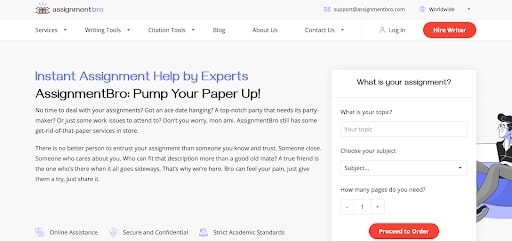
Company’s History. This friendly company belongs to relatively new offerings, yet they have already earned the hearts and minds of school and college students worldwide. They are reputable and always place the client’s needs first, as they are managed by a great team of university graduates who know what students are going through.
Reliability. A plethora of online reviews and the presence of direct contact with a writer makes them reliable. There are free revisions and refunds available as well. Moreover, there are excellent citation tools and writing tools for paraphrasing, a words-to-minutes converter, and a conclusion generator.
Quality of Assignments. Our Law assignment has been delivered on time, and the paper has been free of grammar or style mistakes. The formatting has been done properly, and the content itself has been done professionally with all citations in place.
Prices. As we looked for the best assignment services, we wanted to approach only the most affordable services where the quality still remains high. At AssignmentBro, they do not have a fixed price, which is a good thing because you can negotiate the final price. Our price depended on our subject, the qualification of the writer, and the deadline. It was affordable!
Reviews. Their Sitejabber page shows that they have 4.7 stars based on 53 reviews. People praise them for their affordability and their friendly attitude. The Trustpilot page has 4.4 stars based on 29 reviews. Their writers are always praised as well as their support team.
Customer Support. It deserves six stars out of five because they are the most caring and friendliest when it comes to getting your challenges fixed.
Why Choose It? A young company that is aimed at getting you understood as you ask for academic writing help. Affordable and high-quality writing with a plethora of helpful free tools.
2. A Research Guide

Company’s History. This great service has been around for more than 10 years now, yet they are rarely mentioned when the best assignment writing services are mentioned. The reason for that is that they are not your typical company because it is a great hub for all things research writing. They offer free materials, tutorials, and templates even before you place an order.
Reliability. They cooperate with numerous institutions and businesses as they offer innovative research paper writing assistance and explore all the latest and most efficient ways to deliver excellent research. They have won several awards in the field and represent a fully legit service.
Quality of Assignments. This is where they truly stand out, as their specialists will ask you all the possible questions before they match you with a specialist in their field. We have approached them for a Political Sciences research paper, and they have delivered an excellent paper with credible sources, formatting, and high-quality research.
Prices. The prices start at $14.99 per page and belong to more expensive writing solutions. Still, when you think about the direct communication and assistance that you receive, it’s totally worth it.
Online Reviews. This is where things get rather rough, as the number of reviews is extremely limited. Still, we could find out feedback from professional educators, online course creators, and dissertation-writing students who needed complex research. Their testimonials speak in favor of the company’s reputation.
Customer Support. The support agents represent experienced researchers who will happily guide you through the website and help you with anything. They are available 24/7.
Why Choose It? Look no further if you need serious research paper writing help and want to enjoy freebies that will help you to deliver a perfect assignment.
3. EduBirdie

Company’s History. The company is one of the most famous names in the industry. Their website states that they have been offering legit academic help since 2014. The company runs a blog and stands at the top of technical and academic innovations.
Reliability. They let you talk to your writer directly and provide free paper revisions. If you are not happy with the paper, they offer full refunds. The reviews online show that they are safe to use and follow their promises.
Quality of Assignments. Speaking of online assignment help websites, they offer timely delivery and focus on anything from essay writing and dissertations to personal statement writing and online exams. Placing an order with them, our experts received expert assistance, and the paper contained no grammar, style, or plagiarism issues.
Prices. The prices here start at $13.99 per page and remain affordable if we compare these services to similar offerings online. They implement a bidding system so your final price will depend on the writing quality chosen, the subject, the deadline, and the popularity of your subject.
Online Reviews. This company is constantly mentioned on Sitejabber, Trustpilot, and YouTube (they have their channel), and they are popular among social media users. They are rated at 4.7 out of 5 total points, which is a sign of reliability. Most of their clients are happy with the results.
Customer Support. They are trained well and respond immediately. We had a nice experience talking to the support agents. They are available 24/7 and offer human help with no bots.
Why Choose It? The positive reputation of the company and the chance to talk to your writer directly place them at the top of the most popular assignment help websites you can find these days. They are plagiarism-free and offer reliable quality at an affordable price.
4. SameDayPapers

Company’s History. The company has been around since 2017 and started out in Great Britain and Australia. Later on, they added affordable writing help services in the United States as well. They are the best choice if you are an ESL student or a learner looking for complex custom assignments that focus on Sociology, Psychology, History, or Engineering.
Reliability. They offer free paper revisions and also provide you with a free tool to check your grammar. Regarding the plagiarism, they also let you check things free of charge. Employing native English speakers, they are very strict about their writers and let you cooperate with verified specialists.
Quality of Assignments. Placing an order is easy and logical here, which clearly shows that we are dealing with the best website for assignment help. Checking the paper on Psychology, we can state that it has been delivered even earlier than our deadline. The paper was original, had excellent formatting, and the content has been up to the highest standards.
Prices. They represent an affordable and the best website to do assignments, with their prices starting at $12.99. If you are looking for reliable editing services, the prices will start at $5.5 per page.
Online Reviews. Researching this company’s background, we could locate over two hundred reviews. Most of them are positive and come from the United States, the UK, and Australian users. The total rating is 4.38/5 points.
Customer Support. It’s available for American users, and they respond right away by assisting you with anything from placing an order to finding a specialist that matches your needs.
Why Choose It? It’s one of the global companies that implement verified writers and can offer professional assistance. There are also UK and Australian branches, should you need specific help or sources.
5. EduZaurus

Company’s History. The story of this amazing sample essay database and academic writing company dates back to June 2015. Since then, they have collected a great resource for students coming from all disciplines. The company’s website claims that they have completed over 100,000 assignments as 2021 has started. They provide hundreds of skilled writers, yet what makes them unique is a great collection of free essay samples. It makes them one of the best choices when you need inspiration.
Reliability. Offering legit academic assistance, they can be safely marked as the best assignment writing help service for their collection of samples alone that showcases their work and provides a general idea of what can be expected. There are free revisions and refunds.
Quality of Assignments. Placing an order for the coursework paper in Journalism, we received an excellent document that has been formatted correctly and contained high originality. The grammar and style have been done well. The delivery has been set to only eight hours, yet the paper has been delivered on time.
Prices. Since there are many factors that affect the price per page (writer’s level, your deadline, task specifics), our price has started at $25 per page, yet the general pricing can vary between $20 and $50 if your order is urgent. The prices with a longer deadline start at $12.99 per page. Remember that you should always wait for the best bids to appear.
Online Reviews. Sitejabber users gave them 4.52 stars out of 5 based on 29 reviews. As for TrustPilot, they’ve earned 4.3 out of 5 stars based on 15 testimonials. Most people praise them for being legit and trustworthy.
Customer Support. They have an online chat feature, which is available 24/7. The support remains friendly even if you run into problems.
Why Choose It? This service is the best choice when it comes to finding free samples for inspiration, yet their writing assistance is also up to the highest standards. They cover a wide range of subjects and have a minimum deadline of 3 hours that actually works.
Where Can I Find Trustworthy Assignment Help?
You can find it online, as there are numerous offerings.
As a way to save time, we have tested and evaluated five of the best homework help websites that can be trusted.
Take your time to explore them and see which of them fits your academic needs first.
What is The Best Assignment Help Website You Can Recommend?
While the “best” is always subjective, you may safely check these five entries explored above.
Each of them is different and provides specific benefits in each case
A Research Guide service is the best choice for research paper writing, while EduZaurus will provide you with a great selection of free samples!
Is Assignment Help Described Legit?
Absolutely! Every assignment help website on our list has been tested in terms of being legit .
These services are acknowledged providers of academic help online and are absolutely safe to use, as many online reviews can confirm.
Sharing Your Instructions Well is Essential!
As you are looking through websites that do your homework online, remember that you should always start with careful preparation and sorting of your instructions.
These must be shared with a chosen specialist and have a clear description because it is the only way to achieve success and the necessary degree of clarity.
Although many services like EduBirdie or AssignmentBro let you talk to your writer directly, you must be precise with your instructions and share anything from the assignment grading rubric to the comments and recommendations from your college professor.
It will help you to get the best quality and save time as you avoid mistakes and explain what you expect to see as you place your assignment request.
Regardless if you require research paper writing services or seek an expert who can proofread your work and fix grammar mistakes, sharing your instructions should always come first!
You may also like

Seven Ways to Make your College Essay Stand Out

8 Differences Between Aussie and American Schools

Top 5 Most Difficult IB (International Baccalaureate) Subjects

Benefits of Campus Living: Do Students Living on Campus do...

8 Reasons Why You Should Study Accounting Degrees

8 Best Essay Writing Services According to Reddit and Quora
About the author.

CB Community
Passionate members of the College Basics community that include students, essay writers, consultants and beyond. Please note, while community content has passed our editorial guidelines, we do not endorse any product or service contained in these articles which may also include links for which College Basics is compensated.

Choose Your Test
Sat / act prep online guides and tips, how to do homework: 15 expert tips and tricks.
Coursework/GPA

Everyone struggles with homework sometimes, but if getting your homework done has become a chronic issue for you, then you may need a little extra help. That’s why we’ve written this article all about how to do homework. Once you’re finished reading it, you’ll know how to do homework (and have tons of new ways to motivate yourself to do homework)!
We’ve broken this article down into a few major sections. You’ll find:
- A diagnostic test to help you figure out why you’re struggling with homework
- A discussion of the four major homework problems students face, along with expert tips for addressing them
- A bonus section with tips for how to do homework fast
By the end of this article, you’ll be prepared to tackle whatever homework assignments your teachers throw at you .
So let’s get started!

How to Do Homework: Figure Out Your Struggles
Sometimes it feels like everything is standing between you and getting your homework done. But the truth is, most people only have one or two major roadblocks that are keeping them from getting their homework done well and on time.
The best way to figure out how to get motivated to do homework starts with pinpointing the issues that are affecting your ability to get your assignments done. That’s why we’ve developed a short quiz to help you identify the areas where you’re struggling.
Take the quiz below and record your answers on your phone or on a scrap piece of paper. Keep in mind there are no wrong answers!
1. You’ve just been assigned an essay in your English class that’s due at the end of the week. What’s the first thing you do?
A. Keep it in mind, even though you won’t start it until the day before it’s due B. Open up your planner. You’ve got to figure out when you’ll write your paper since you have band practice, a speech tournament, and your little sister’s dance recital this week, too. C. Groan out loud. Another essay? You could barely get yourself to write the last one! D. Start thinking about your essay topic, which makes you think about your art project that’s due the same day, which reminds you that your favorite artist might have just posted to Instagram...so you better check your feed right now.
2. Your mom asked you to pick up your room before she gets home from work. You’ve just gotten home from school. You decide you’ll tackle your chores:
A. Five minutes before your mom walks through the front door. As long as it gets done, who cares when you start? B. As soon as you get home from your shift at the local grocery store. C. After you give yourself a 15-minute pep talk about how you need to get to work. D. You won’t get it done. Between texts from your friends, trying to watch your favorite Netflix show, and playing with your dog, you just lost track of time!
3. You’ve signed up to wash dogs at the Humane Society to help earn money for your senior class trip. You:
A. Show up ten minutes late. You put off leaving your house until the last minute, then got stuck in unexpected traffic on the way to the shelter. B. Have to call and cancel at the last minute. You forgot you’d already agreed to babysit your cousin and bake cupcakes for tomorrow’s bake sale. C. Actually arrive fifteen minutes early with extra brushes and bandanas you picked up at the store. You’re passionate about animals, so you’re excited to help out! D. Show up on time, but only get three dogs washed. You couldn’t help it: you just kept getting distracted by how cute they were!
4. You have an hour of downtime, so you decide you’re going to watch an episode of The Great British Baking Show. You:
A. Scroll through your social media feeds for twenty minutes before hitting play, which means you’re not able to finish the whole episode. Ugh! You really wanted to see who was sent home! B. Watch fifteen minutes until you remember you’re supposed to pick up your sister from band practice before heading to your part-time job. No GBBO for you! C. You finish one episode, then decide to watch another even though you’ve got SAT studying to do. It’s just more fun to watch people make scones. D. Start the episode, but only catch bits and pieces of it because you’re reading Twitter, cleaning out your backpack, and eating a snack at the same time.
5. Your teacher asks you to stay after class because you’ve missed turning in two homework assignments in a row. When she asks you what’s wrong, you say:
A. You planned to do your assignments during lunch, but you ran out of time. You decided it would be better to turn in nothing at all than submit unfinished work. B. You really wanted to get the assignments done, but between your extracurriculars, family commitments, and your part-time job, your homework fell through the cracks. C. You have a hard time psyching yourself to tackle the assignments. You just can’t seem to find the motivation to work on them once you get home. D. You tried to do them, but you had a hard time focusing. By the time you realized you hadn’t gotten anything done, it was already time to turn them in.
Like we said earlier, there are no right or wrong answers to this quiz (though your results will be better if you answered as honestly as possible). Here’s how your answers break down:
- If your answers were mostly As, then your biggest struggle with doing homework is procrastination.
- If your answers were mostly Bs, then your biggest struggle with doing homework is time management.
- If your answers were mostly Cs, then your biggest struggle with doing homework is motivation.
- If your answers were mostly Ds, then your biggest struggle with doing homework is getting distracted.
Now that you’ve identified why you’re having a hard time getting your homework done, we can help you figure out how to fix it! Scroll down to find your core problem area to learn more about how you can start to address it.
And one more thing: you’re really struggling with homework, it’s a good idea to read through every section below. You may find some additional tips that will help make homework less intimidating.

How to Do Homework When You’re a Procrastinator
Merriam Webster defines “procrastinate” as “to put off intentionally and habitually.” In other words, procrastination is when you choose to do something at the last minute on a regular basis. If you’ve ever found yourself pulling an all-nighter, trying to finish an assignment between periods, or sprinting to turn in a paper minutes before a deadline, you’ve experienced the effects of procrastination.
If you’re a chronic procrastinator, you’re in good company. In fact, one study found that 70% to 95% of undergraduate students procrastinate when it comes to doing their homework. Unfortunately, procrastination can negatively impact your grades. Researchers have found that procrastination can lower your grade on an assignment by as much as five points ...which might not sound serious until you realize that can mean the difference between a B- and a C+.
Procrastination can also negatively affect your health by increasing your stress levels , which can lead to other health conditions like insomnia, a weakened immune system, and even heart conditions. Getting a handle on procrastination can not only improve your grades, it can make you feel better, too!
The big thing to understand about procrastination is that it’s not the result of laziness. Laziness is defined as being “disinclined to activity or exertion.” In other words, being lazy is all about doing nothing. But a s this Psychology Today article explains , procrastinators don’t put things off because they don’t want to work. Instead, procrastinators tend to postpone tasks they don’t want to do in favor of tasks that they perceive as either more important or more fun. Put another way, procrastinators want to do things...as long as it’s not their homework!
3 Tips f or Conquering Procrastination
Because putting off doing homework is a common problem, there are lots of good tactics for addressing procrastination. Keep reading for our three expert tips that will get your homework habits back on track in no time.
#1: Create a Reward System
Like we mentioned earlier, procrastination happens when you prioritize other activities over getting your homework done. Many times, this happens because homework...well, just isn’t enjoyable. But you can add some fun back into the process by rewarding yourself for getting your work done.
Here’s what we mean: let’s say you decide that every time you get your homework done before the day it’s due, you’ll give yourself a point. For every five points you earn, you’ll treat yourself to your favorite dessert: a chocolate cupcake! Now you have an extra (delicious!) incentive to motivate you to leave procrastination in the dust.
If you’re not into cupcakes, don’t worry. Your reward can be anything that motivates you . Maybe it’s hanging out with your best friend or an extra ten minutes of video game time. As long as you’re choosing something that makes homework worth doing, you’ll be successful.
#2: Have a Homework Accountability Partner
If you’re having trouble getting yourself to start your homework ahead of time, it may be a good idea to call in reinforcements . Find a friend or classmate you can trust and explain to them that you’re trying to change your homework habits. Ask them if they’d be willing to text you to make sure you’re doing your homework and check in with you once a week to see if you’re meeting your anti-procrastination goals.
Sharing your goals can make them feel more real, and an accountability partner can help hold you responsible for your decisions. For example, let’s say you’re tempted to put off your science lab write-up until the morning before it’s due. But you know that your accountability partner is going to text you about it tomorrow...and you don’t want to fess up that you haven’t started your assignment. A homework accountability partner can give you the extra support and incentive you need to keep your homework habits on track.
#3: Create Your Own Due Dates
If you’re a life-long procrastinator, you might find that changing the habit is harder than you expected. In that case, you might try using procrastination to your advantage! If you just can’t seem to stop doing your work at the last minute, try setting your own due dates for assignments that range from a day to a week before the assignment is actually due.
Here’s what we mean. Let’s say you have a math worksheet that’s been assigned on Tuesday and is due on Friday. In your planner, you can write down the due date as Thursday instead. You may still put off your homework assignment until the last minute...but in this case, the “last minute” is a day before the assignment’s real due date . This little hack can trick your procrastination-addicted brain into planning ahead!

If you feel like Kevin Hart in this meme, then our tips for doing homework when you're busy are for you.
How to Do Homework When You’re too Busy
If you’re aiming to go to a top-tier college , you’re going to have a full plate. Because college admissions is getting more competitive, it’s important that you’re maintaining your grades , studying hard for your standardized tests , and participating in extracurriculars so your application stands out. A packed schedule can get even more hectic once you add family obligations or a part-time job to the mix.
If you feel like you’re being pulled in a million directions at once, you’re not alone. Recent research has found that stress—and more severe stress-related conditions like anxiety and depression— are a major problem for high school students . In fact, one study from the American Psychological Association found that during the school year, students’ stress levels are higher than those of the adults around them.
For students, homework is a major contributor to their overall stress levels . Many high schoolers have multiple hours of homework every night , and figuring out how to fit it into an already-packed schedule can seem impossible.
3 Tips for Fitting Homework Into Your Busy Schedule
While it might feel like you have literally no time left in your schedule, there are still ways to make sure you’re able to get your homework done and meet your other commitments. Here are our expert homework tips for even the busiest of students.
#1: Make a Prioritized To-Do List
You probably already have a to-do list to keep yourself on track. The next step is to prioritize the items on your to-do list so you can see what items need your attention right away.
Here’s how it works: at the beginning of each day, sit down and make a list of all the items you need to get done before you go to bed. This includes your homework, but it should also take into account any practices, chores, events, or job shifts you may have. Once you get everything listed out, it’s time to prioritize them using the labels A, B, and C. Here’s what those labels mean:
- A Tasks : tasks that have to get done—like showing up at work or turning in an assignment—get an A.
- B Tasks : these are tasks that you would like to get done by the end of the day but aren’t as time sensitive. For example, studying for a test you have next week could be a B-level task. It’s still important, but it doesn’t have to be done right away.
- C Tasks: these are tasks that aren’t very important and/or have no real consequences if you don’t get them done immediately. For instance, if you’re hoping to clean out your closet but it’s not an assigned chore from your parents, you could label that to-do item with a C.
Prioritizing your to-do list helps you visualize which items need your immediate attention, and which items you can leave for later. A prioritized to-do list ensures that you’re spending your time efficiently and effectively, which helps you make room in your schedule for homework. So even though you might really want to start making decorations for Homecoming (a B task), you’ll know that finishing your reading log (an A task) is more important.
#2: Use a Planner With Time Labels
Your planner is probably packed with notes, events, and assignments already. (And if you’re not using a planner, it’s time to start!) But planners can do more for you than just remind you when an assignment is due. If you’re using a planner with time labels, it can help you visualize how you need to spend your day.
A planner with time labels breaks your day down into chunks, and you assign tasks to each chunk of time. For example, you can make a note of your class schedule with assignments, block out time to study, and make sure you know when you need to be at practice. Once you know which tasks take priority, you can add them to any empty spaces in your day.
Planning out how you spend your time not only helps you use it wisely, it can help you feel less overwhelmed, too . We’re big fans of planners that include a task list ( like this one ) or have room for notes ( like this one ).
#3: Set Reminders on Your Phone
If you need a little extra nudge to make sure you’re getting your homework done on time, it’s a good idea to set some reminders on your phone. You don’t need a fancy app, either. You can use your alarm app to have it go off at specific times throughout the day to remind you to do your homework. This works especially well if you have a set homework time scheduled. So if you’ve decided you’re doing homework at 6:00 pm, you can set an alarm to remind you to bust out your books and get to work.
If you use your phone as your planner, you may have the option to add alerts, emails, or notifications to scheduled events . Many calendar apps, including the one that comes with your phone, have built-in reminders that you can customize to meet your needs. So if you block off time to do your homework from 4:30 to 6:00 pm, you can set a reminder that will pop up on your phone when it’s time to get started.

This dog isn't judging your lack of motivation...but your teacher might. Keep reading for tips to help you motivate yourself to do your homework.
How to Do Homework When You’re Unmotivated
At first glance, it may seem like procrastination and being unmotivated are the same thing. After all, both of these issues usually result in you putting off your homework until the very last minute.
But there’s one key difference: many procrastinators are working, they’re just prioritizing work differently. They know they’re going to start their homework...they’re just going to do it later.
Conversely, people who are unmotivated to do homework just can’t find the willpower to tackle their assignments. Procrastinators know they’ll at least attempt the homework at the last minute, whereas people who are unmotivated struggle with convincing themselves to do it at a ll. For procrastinators, the stress comes from the inevitable time crunch. For unmotivated people, the stress comes from trying to convince themselves to do something they don’t want to do in the first place.
Here are some common reasons students are unmotivated in doing homework :
- Assignments are too easy, too hard, or seemingly pointless
- Students aren’t interested in (or passionate about) the subject matter
- Students are intimidated by the work and/or feels like they don’t understand the assignment
- Homework isn’t fun, and students would rather spend their time on things that they enjoy
To sum it up: people who lack motivation to do their homework are more likely to not do it at all, or to spend more time worrying about doing their homework than...well, actually doing it.
3 Tips for How to Get Motivated to Do Homework
The key to getting homework done when you’re unmotivated is to figure out what does motivate you, then apply those things to homework. It sounds tricky...but it’s pretty simple once you get the hang of it! Here are our three expert tips for motivating yourself to do your homework.
#1: Use Incremental Incentives
When you’re not motivated, it’s important to give yourself small rewards to stay focused on finishing the task at hand. The trick is to keep the incentives small and to reward yourself often. For example, maybe you’re reading a good book in your free time. For every ten minutes you spend on your homework, you get to read five pages of your book. Like we mentioned earlier, make sure you’re choosing a reward that works for you!
So why does this technique work? Using small rewards more often allows you to experience small wins for getting your work done. Every time you make it to one of your tiny reward points, you get to celebrate your success, which gives your brain a boost of dopamine . Dopamine helps you stay motivated and also creates a feeling of satisfaction when you complete your homework !
#2: Form a Homework Group
If you’re having trouble motivating yourself, it’s okay to turn to others for support. Creating a homework group can help with this. Bring together a group of your friends or classmates, and pick one time a week where you meet and work on homework together. You don’t have to be in the same class, or even taking the same subjects— the goal is to encourage one another to start (and finish!) your assignments.
Another added benefit of a homework group is that you can help one another if you’re struggling to understand the material covered in your classes. This is especially helpful if your lack of motivation comes from being intimidated by your assignments. Asking your friends for help may feel less scary than talking to your teacher...and once you get a handle on the material, your homework may become less frightening, too.
#3: Change Up Your Environment
If you find that you’re totally unmotivated, it may help if you find a new place to do your homework. For example, if you’ve been struggling to get your homework done at home, try spending an extra hour in the library after school instead. The change of scenery can limit your distractions and give you the energy you need to get your work done.
If you’re stuck doing homework at home, you can still use this tip. For instance, maybe you’ve always done your homework sitting on your bed. Try relocating somewhere else, like your kitchen table, for a few weeks. You may find that setting up a new “homework spot” in your house gives you a motivational lift and helps you get your work done.

Social media can be a huge problem when it comes to doing homework. We have advice for helping you unplug and regain focus.
How to Do Homework When You’re Easily Distracted
We live in an always-on world, and there are tons of things clamoring for our attention. From friends and family to pop culture and social media, it seems like there’s always something (or someone!) distracting us from the things we need to do.
The 24/7 world we live in has affected our ability to focus on tasks for prolonged periods of time. Research has shown that over the past decade, an average person’s attention span has gone from 12 seconds to eight seconds . And when we do lose focus, i t takes people a long time to get back on task . One study found that it can take as long as 23 minutes to get back to work once we’ve been distracte d. No wonder it can take hours to get your homework done!
3 Tips to Improve Your Focus
If you have a hard time focusing when you’re doing your homework, it’s a good idea to try and eliminate as many distractions as possible. Here are three expert tips for blocking out the noise so you can focus on getting your homework done.
#1: Create a Distraction-Free Environment
Pick a place where you’ll do your homework every day, and make it as distraction-free as possible. Try to find a location where there won’t be tons of noise, and limit your access to screens while you’re doing your homework. Put together a focus-oriented playlist (or choose one on your favorite streaming service), and put your headphones on while you work.
You may find that other people, like your friends and family, are your biggest distraction. If that’s the case, try setting up some homework boundaries. Let them know when you’ll be working on homework every day, and ask them if they’ll help you keep a quiet environment. They’ll be happy to lend a hand!
#2: Limit Your Access to Technology
We know, we know...this tip isn’t fun, but it does work. For homework that doesn’t require a computer, like handouts or worksheets, it’s best to put all your technology away . Turn off your television, put your phone and laptop in your backpack, and silence notifications on any wearable tech you may be sporting. If you listen to music while you work, that’s fine...but make sure you have a playlist set up so you’re not shuffling through songs once you get started on your homework.
If your homework requires your laptop or tablet, it can be harder to limit your access to distractions. But it’s not impossible! T here are apps you can download that will block certain websites while you’re working so that you’re not tempted to scroll through Twitter or check your Facebook feed. Silence notifications and text messages on your computer, and don’t open your email account unless you absolutely have to. And if you don’t need access to the internet to complete your assignments, turn off your WiFi. Cutting out the online chatter is a great way to make sure you’re getting your homework done.
#3: Set a Timer (the Pomodoro Technique)
Have you ever heard of the Pomodoro technique ? It’s a productivity hack that uses a timer to help you focus!
Here’s how it works: first, set a timer for 25 minutes. This is going to be your work time. During this 25 minutes, all you can do is work on whatever homework assignment you have in front of you. No email, no text messaging, no phone calls—just homework. When that timer goes off, you get to take a 5 minute break. Every time you go through one of these cycles, it’s called a “pomodoro.” For every four pomodoros you complete, you can take a longer break of 15 to 30 minutes.
The pomodoro technique works through a combination of boundary setting and rewards. First, it gives you a finite amount of time to focus, so you know that you only have to work really hard for 25 minutes. Once you’ve done that, you’re rewarded with a short break where you can do whatever you want. Additionally, tracking how many pomodoros you complete can help you see how long you’re really working on your homework. (Once you start using our focus tips, you may find it doesn’t take as long as you thought!)

Two Bonus Tips for How to Do Homework Fast
Even if you’re doing everything right, there will be times when you just need to get your homework done as fast as possible. (Why do teachers always have projects due in the same week? The world may never know.)
The problem with speeding through homework is that it’s easy to make mistakes. While turning in an assignment is always better than not submitting anything at all, you want to make sure that you’re not compromising quality for speed. Simply put, the goal is to get your homework done quickly and still make a good grade on the assignment!
Here are our two bonus tips for getting a decent grade on your homework assignments , even when you’re in a time crunch.
#1: Do the Easy Parts First
This is especially true if you’re working on a handout with multiple questions. Before you start working on the assignment, read through all the questions and problems. As you do, make a mark beside the questions you think are “easy” to answer .
Once you’ve finished going through the whole assignment, you can answer these questions first. Getting the easy questions out of the way as quickly as possible lets you spend more time on the trickier portions of your homework, which will maximize your assignment grade.
(Quick note: this is also a good strategy to use on timed assignments and tests, like the SAT and the ACT !)
#2: Pay Attention in Class
Homework gets a lot easier when you’re actively learning the material. Teachers aren’t giving you homework because they’re mean or trying to ruin your weekend... it’s because they want you to really understand the course material. Homework is designed to reinforce what you’re already learning in class so you’ll be ready to tackle harder concepts later.
When you pay attention in class, ask questions, and take good notes, you’re absorbing the information you’ll need to succeed on your homework assignments. (You’re stuck in class anyway, so you might as well make the most of it!) Not only will paying attention in class make your homework less confusing, it will also help it go much faster, too.

What’s Next?
If you’re looking to improve your productivity beyond homework, a good place to begin is with time management. After all, we only have so much time in a day...so it’s important to get the most out of it! To get you started, check out this list of the 12 best time management techniques that you can start using today.
You may have read this article because homework struggles have been affecting your GPA. Now that you’re on the path to homework success, it’s time to start being proactive about raising your grades. This article teaches you everything you need to know about raising your GPA so you can
Now you know how to get motivated to do homework...but what about your study habits? Studying is just as critical to getting good grades, and ultimately getting into a good college . We can teach you how to study bette r in high school. (We’ve also got tons of resources to help you study for your ACT and SAT exams , too!)
These recommendations are based solely on our knowledge and experience. If you purchase an item through one of our links, PrepScholar may receive a commission.

Ashley Sufflé Robinson has a Ph.D. in 19th Century English Literature. As a content writer for PrepScholar, Ashley is passionate about giving college-bound students the in-depth information they need to get into the school of their dreams.
Student and Parent Forum
Our new student and parent forum, at ExpertHub.PrepScholar.com , allow you to interact with your peers and the PrepScholar staff. See how other students and parents are navigating high school, college, and the college admissions process. Ask questions; get answers.

Ask a Question Below
Have any questions about this article or other topics? Ask below and we'll reply!
Improve With Our Famous Guides
- For All Students
The 5 Strategies You Must Be Using to Improve 160+ SAT Points
How to Get a Perfect 1600, by a Perfect Scorer
Series: How to Get 800 on Each SAT Section:
Score 800 on SAT Math
Score 800 on SAT Reading
Score 800 on SAT Writing
Series: How to Get to 600 on Each SAT Section:
Score 600 on SAT Math
Score 600 on SAT Reading
Score 600 on SAT Writing
Free Complete Official SAT Practice Tests
What SAT Target Score Should You Be Aiming For?
15 Strategies to Improve Your SAT Essay
The 5 Strategies You Must Be Using to Improve 4+ ACT Points
How to Get a Perfect 36 ACT, by a Perfect Scorer
Series: How to Get 36 on Each ACT Section:
36 on ACT English
36 on ACT Math
36 on ACT Reading
36 on ACT Science
Series: How to Get to 24 on Each ACT Section:
24 on ACT English
24 on ACT Math
24 on ACT Reading
24 on ACT Science
What ACT target score should you be aiming for?
ACT Vocabulary You Must Know
ACT Writing: 15 Tips to Raise Your Essay Score
How to Get Into Harvard and the Ivy League
How to Get a Perfect 4.0 GPA
How to Write an Amazing College Essay
What Exactly Are Colleges Looking For?
Is the ACT easier than the SAT? A Comprehensive Guide
Should you retake your SAT or ACT?
When should you take the SAT or ACT?
Stay Informed
Get the latest articles and test prep tips!
Looking for Graduate School Test Prep?
Check out our top-rated graduate blogs here:
GRE Online Prep Blog
GMAT Online Prep Blog
TOEFL Online Prep Blog
Holly R. "I am absolutely overjoyed and cannot thank you enough for helping me!”

Request for Assignment
Trusted online assignment help website.
GradeHood is one of the best assignment writing websites for high school, college, and university students! Our online assignment helps services connect you with experienced assignment helpers who can assist with your academic needs. Whether you need someone to "do my assignment" or require help with your homework, we’re here to support you. We understand the challenges students face in managing their academic workload. That’s why we offer comprehensive assignment help services. When you ask us to “help me with my assignment,” our expertise alleviates your academic stress and ensures top-notch grades.
Explore the World of Physics with Our Comprehensive Homework Help
Our assignment help services.
At GradeHood, we provide a wide array of online assignment help services. Our assignment writing website meets diverse academic needs as per the student’s class and curriculum
Customized Assignment Solutions
Our experienced team of subject matter experts delivers custom-tailored assignments. If you need assignment help crafted to match your specific requirements and academic standards, then GradeHood is the name to remember.
Plagiarism-Free Work
We guarantee original, plagiarism-free content when you ask us to “help me with my assignment.” Our rigorous quality checks make us a preferred provider of online assignment help services. Our assignment writing website ensures the authenticity and uniqueness of every solution.
Timely Delivery
Meeting deadlines is our forte as an expert in assignment help services. We value your time when you ask us to “help me with my assignment.” We ensure that your assignments are delivered promptly without compromising quality.
Subject Expertise
Our team comprises qualified professionals across various fields. As a result, your assignments will be handled by experts in the respective subjects. They will be your guide in your query, “Do my assignment.”
24/7 Support
We provide round-the-clock customer support to help in “Do my assignment”. We address your queries and concerns promptly to ensure a seamless experience.
Unlimited Revisions
We believe in delivering perfection when you ask us to “Do my assignment”. If you require any modifications or revisions, our assignment writing website offers unlimited revisions until you are completely satisfied.
What Clients Say About Our Writing Services?
At GradeHood, we strive to be your ultimate academic companion. Our assignment writing website provides top-quality assignment help services that empower you to excel in your academic journey. With our commitment to excellence and customer satisfaction, we aim to be the support system you can rely on for all your assignment needs.Here is what our happy clients have to say about our expertise in assignment help service when they ask us to “help me with my assignment.”

"The AI/ML course is fantastic! The instructors are patient and engaging. The Python labs are hands-on, which is exactly what I needed to learn."
"GradeHood's Python help has been a lifesaver. From data wrangling to advanced ML, their experts cover it all. The interactive lessons are gold!"
"The AI algorithms taught here are on point. The practical sessions on deep learning were a highlight. My AI models have improved significantly!"
Top Professional Writers for Assignment Help Service
Gradehood is a provider of reliable and trustworthy assignment help related services that connect learners who need assistance to Top-ranked Professional Experts. All our Experts have immense knowledge of their subjects and help students with the desired support.

We provide assignment and homework help in these subjects
Chemistry Homework Help
Chemistry may involve diverse topics. These include balancing equations to understand complex concepts like organic chemistry or chemical kinetics. Our assistance ensures clarity and proficiency in tackling these chemistry assignments and homework topics.
Physics Homework Help
Be it mechanics, electromagnetism, or thermodynamics, the subject matter in Physics is vast. Let our support help solve problems in assignments and homework. This way, you can better understand the intricacies of physics concepts and calculations when you ask us to “Do my assignment”.
Biology Homework Help
The biology field encompasses genetics, ecology, and human biology. Our expert tutors guide students through scientific concepts, lab reports, and detailed assignments for a comprehensive understanding.
Civil Homework Help
Our expertise spans structural analysis, transportation engineering, and environmental studies. This way, we provide guidance in solving problems related to civil engineering projects, homework, and assignments when you ask us to “help me with my assignment.”
Computer Homework Help
Computer homework and assignments may span programming languages, data structures, and software development. Trust our dependable homework and assignment help experts in this subject. We will help complete your homework and offer unmatched clarity and proficiency in computer science concepts and coding challenges.
Electronics Homework Help
our assignment and homework help experts will cover topics such as electronic circuits, semiconductor devices, and digital electronics. This way, we provide support for understanding complex electronics principles and problem-solving.
Mechanical Engineering Homework Help
Rely on our skills in completing assignments and homework for an array of topics. These may include mechanics, design, and manufacturing. It becomes easier for you to comprehend complex mechanical engineering concepts and solve engineering problems.
Engineering Homework Help
We cover different engineering disciplines with ease. Our homework and assignment experts present guidance tailored to individual fields. As an outcome, this assistance boosts your problem-solving skills and gives you a chance to score well in exams.
MATLAB Homework Help
Assisting in MATLAB coding, data analysis, and simulations, our guidance ensures effective usage and understanding of MATLAB’s computational capabilities.
Math Homework Help
From algebra to calculus and beyond, we can get it done for Math homework, projects, and assignments. Our assignment helpers aid in solving complex mathematical problems. They also offer step-by-step explanations and reinforce your fundamental concepts.
Python Assignment Help
Our support covers Python programming, debugging, and application development. This skill enables students to grasp the language’s nuances and apply them effectively.
Electrical Engineering Homework Help
Rely on our competent assignment to help experts on versatile topics like circuits, control systems, and electronics. This all-round assistance ensures a better grasp of electrical engineering principles and problem-solving skills.

- Degree BTech
- Total Orders 22

- Total Orders 14

- Degree MTech
- Total Orders 27
How to Order Assignment Help Service?
At GradeHood, we’re all about supporting students with assignments, projects, and homework. Our secret? A team of subject experts who know their stuff inside out. They’ll guide you through the trickiest subjects and ensure your work is on point every time. We know the immense importance of deadlines in your academic journey. That’s why we’re all about delivering your work on time. With us, you’ll manage your workload like a pro without missing due dates. Every task is unique, and that’s how we treat it. Our approach is totally customized. Hence, it matches your learning style and fits your requirements perfectly. Expect assignments that reflect your understanding and originality. We’re not just here to finish tasks; we are here to boost your knowledge. GradeHood isn’t just a homework solution. Rather, it is a way to grasp concepts better, diving into subjects for a deeper understanding. Your work will always be authentic and original. We are serious about academic honesty and integrity. Need help understanding a concept? We’re there for you. Whether it is a quick assignment or a complex project, GradeHood covers a wide range of subjects. This USP ensures that you have got support for everything. Think of GradeHood as your academic companion. Our team is reliable, consistent, and there for you throughout your academic journey. We’re here to help you excel and succeed in your studies every step of the way.

Here is how you can get started with ordering assignments from us at GradeHood.

We need your assignment and instructions for it. Just fill out a short Order form along with the instructions and the Deadline for submission.

Our team will check the assignment you sent through the Order form and send you the price quote for it. The price is quoted based on the type of assignment- Subject, Length, and Complexity. Once you make the payment, we assign the best available expert to your assignment.

Once your assignment is done and completed, you can download it and check it to meet all the requirements. You can provide any feedback or revisions needed in it.
To know more about the ordering and tracking steps, click HOW TO ORDER
How it Works

Sign up with us and embark on your journey of Online Tutoring
Select your area/s of expertise and assignments based on your availability
Receive weekly payments for all successfully submitted solutions
Stick to the deadlines and submit step by step and correct solutions
Why Gradehood Services – Our USP in Assignment Help Service
GradeHood is your reliable partner in academic excellence. If you have a query, "Do my assignment," then you will always find GradeHood by your side. We understand the challenges students face in managing their academic workload. They have to juggle multiple assignments and strive to meet strict deadlines.
As a trusted online assignment help website, GradeHood aims to alleviate these pressures. This is accomplished by providing comprehensive solutions tailored to your academic needs.
Our commitment to quality, reliability, and customer satisfaction is evident in our services. These are carefully curated to assist students in achieving their academic goals.
Explore our array of services and discover why GradeHood stands out as the preferred choice for students seeking expert assistance in their academic journey.
GradeHood offers personalized assignment solutions crafted meticulously to meet your specific academic requirements. Our expert team ensures that each assignment adheres to your guidelines and academic standards. This facilitates a tailored approach to your learning.
We guarantee original and authentic content in every assignment. Our thorough quality checks and plagiarism detection tools. This facilitates deliverables that are free from any form of plagiarism. Your assignment will definitely maintain academic integrity with our assistance as an assignment helper.
Meeting deadlines is a priority at GradeHood. We understand the importance of timely submission. Our commitment ensures that your assignments are delivered promptly. We achieve this goal without compromising on quality.
Our team comprises qualified professionals across various academic disciplines, providing you access to experts in each subject. This ensures that your assignments are handled by competent individuals. They have in-depth knowledge and expertise in their respective fields.
We are dedicated to providing round-the-clock customer support. Our responsive team is available at all times to address your queries and concerns. Thus, you get 100% assistance whenever you need it.
We believe in delivering perfection when you ask us to “Do my assignment”. If any adjustments or modifications are required, GradeHood offers unlimited revisions. As an outcome, the final assignment aligns with your expectations and requirements.
Here are some benefits of using GradeHood services

When you hire someone to write a paper, you want the completed text to meet the originality demands of your institution. With our essay writing service, you can rest assured that your papers are 100% unique. You can request detailed originality reports free of charge.

Round the Clock Customer Care Support
Our experts are available round the clock to assist you with your assignments whenever you need Help with Assignments.

End Number of Amendments
We value feedback and provide an unlimited number of revisions for the assignment until it meets your highest standards.
FREE Bonuses
Assignment writing service faqs, what is assignment help, and how can it benefit students, how can an assignment help website assist me in completing my assignments, why should i choose an online assignment help service over traditional methods, is it safe to get homework help online from gradehood, how qualified are the experts providing homework help, your trusted online assignment help services.
- Homework Help
- Essay Writing
- Proofreading/Editing
- Case studies
- Coding Assignment
- Mathematics
- Computer Science
- Mechanical Engineering
- Civil Engineering
- Electrical Engineering
- Artificial Intelligence
- Machine Learning
- Encryption and Coding
- Business Administration
- Accountancy
- R-Programming
Join Our Promotion Plans
By signing up, I agree to Gradehood Terms & Conditions, Trust and Privacy Policy
The 10 Best Study Planning Apps for All Students
These study planner apps for Android and iPhone help you get organized in school by tracking your assignments, tests, and other coursework.
As a student, you're responsible for keeping track of test dates, quizzes, homework assignments, and final exams. On top of that, maybe you partake in after-school activities and sports. This makes it even harder for you to keep track of due dates and tests.
If you feel that you're sinking into a pile of assignments, you need to add some organization to your life. These are some of the best study planner apps for Android and iOS that can help you set times to study and remind you of upcoming exams, so you're not caught off-guard.
Chipper is one of the most popular and best study planners for students. Using Chipper can greatly improve your time-management skills.
This study planning app comes equipped with several tools dedicated to students . Simply add all the courses that you're currently taking, and organize them by time and date in the built-in schedule.
Chipper also allows you to add tests, homework due dates, papers, labs, and quizzes to your calendar to help you stay on top of your coursework. On top of that, you can set reminders that Chipper will send as notifications, so you never miss a deadline. And when you're ready to study, open the Study tab to set a timer for your session.
That means you don't need to download a Pomodoro timer app for such. But if you do, here are the best Pomodoro timer apps .
This app rewards you with earnings in the form of imaginary cash as you complete tasks. You don't actually receive any of these earnings in real life, but it's a good incentive to keep you moving forward.
Download: Chipper for Android (Free, in-app purchases available)
2. Classify
Use Classify to build an easy-to-read schedule for your homework assignments, projects, quizzes, and other activities. Because it has a clear and simple interface and a lot of useful features, it is a unique study tracker app.
Classify helps you organize your school life by adding everything important in one place. It also provides templates for tasks, homework assignments, and events. For example, you can attach a PDF when you add an assignment, and you can set priorities for tasks.
Simply add this semester's courses, along with assignments and their due dates. Classify will let you know when your assignments are due and give you helpful reminders about upcoming deadlines, making it a great study planner app for students. Additionally, it has a Pomodoro functionality built-in if you fancy using the Pomodoro technique .
Download: Classify for iOS | Android (Free)
3. My Study Life
My Study Life is yet another great study planner app you should try today. With My Study Life, you can easily add tasks, classes, and exams to a weekly schedule template for students. When you add your classes, you can input detailed information about them such as the room number, module, time, and even the teacher.
If you struggle to remember holidays or class rotations, you can input that information in My Study Life as well. Your dashboard displays all your upcoming assignments, exams, and classes. This way, you'll never forget about that assignment that's due tomorrow.
Download: My Study Life for iOS | Android (Free)
4. Power Planner
Power Planner is a clean and simple study schedule app that's perfect for middle school, high school, and even college students.
As one of the most useful apps for every student , it helps you remember class times, keep track of tests, and can assist you with staying on top of your assignments.
Power Planner integrates with Google Calendar to make your life even easier. Better yet, you can also estimate your GPA by inputting assignment and test grades.
However, if you want to add more than one semester and five grades per class, you'll have to spend a few dollars on the premium version.
Download: Power Planner for iOS | Android (Free, in-app purchases available)
5. Lessons School Planner
Lessons School Planner is a study tracking app that is built with simplicity in mind ensuring your energy is focused on increasing productivity and getting work done instead of organization. It can be likened to a simple to-do list tool but for students. When you download the app, you can start by creating a custom lesson plan, or importing one if you have it already on another device.
The app has lessons added already, but you can customize them depending on your needs. It makes organization easier by using a number system to organize lessons.
Tapping on a subject on your daily lesson plan allows you to add activities related to it, like an upcoming assignment submission deadline, exam, test, project, presentation, and more. These activities can then be viewed on a dedicated page. The app also allows you to set reminders for your tasks, ensuring that you don't miss out on anything important.
Download: Lessons for Android (Free, in-app purchases available)
6. Study Bunny: Focus Timer
Study Bunny is a less conventional study tracker app, but it makes studying a lot more fun. For starters, it introduces you to an adorable cartoon bunny that acts as your study partner.
You can use the app to time study sessions, create awesome to-do lists , make flashcards, and keep track of your progress.
When you start studying, you'll earn coins that you can use to treat the bunny. You can buy items to feed and customize your pal, which will help motivate you to finish a long study session.
Download: Study Bunny: Focus Timer for iOS | Android (Free, in-app purchases available)
Vaia (formerly StudySmarter) is a helpful study-planning app that lets you collaborate with other students from around the world.
To help you save time, the app allows for shareable flashcards. This means that you can search for and use flashcards that other users have already made which makes learning easier. As a study planner app for students, Vaia is also featured in our list of the best flash card apps .
In addition to that handy feature, Vaia lets you upload and annotate documents, as well as create study groups with students from other universities. And when you want to check your progress, you can use the app's built-in charts to visualize your study time and see if you're meeting your weekly goals.
Download: Vaia for iOS | Android (Free, in-app purchases available)
8. myHomework Student Planner
The myHomework Student Planner app is a straightforward way to keep tabs on your studies. To get started, you simply have to input your class schedule and any upcoming assignments.
myHomework Student Planner will then generate a color-coded class schedule, as well as a calendar that organizes your upcoming classes, assignments, and tests. Besides that, it also creates a clean list of homework assignments, which makes it much easier to remember important due dates.
Download: myHomework Student Planner for iOS | Android (Free, in-app purchases available)
9. Smart Timetable
To get started on Smart Timetable, add your classes as events with how often you want to study for them. When it's time to hunker down, Smart Timetable will send a notification to your phone as a reminder.
The app allows you to input additional information about each class including the type, building and room number, and instructor, and you can even upload class notes. Each day the app's home page has the day's classes, and you can swipe left to view upcoming classes in the follow-up days.
There's also a task tab where you can add your upcoming assignments and tick them off once you're done.
Download: Smart Timetable for Android (Free, subscription available)
10. School Planner
The School Planner app has a ton of versatility when it comes to schedule options. You can input your classes into the app by using the available easy-to-use default templates.
Templates include everything you need to stay on top of your classes, including day, time, teacher, subject, frequency, and room. You also have the ability to add any upcoming events, whether it's a simple reminder, an upcoming exam, or a homework submission deadline.
All the upcoming tasks will show up on the app's home page in a sleek Overview page with a snapshot of any upcoming events in the next seven days, what's on your schedule today, tomorrow, and a detailed outlook of the upcoming week. School Planner's interface and organization make it one of the best study scheduling apps around.
The experience isn't limited to class times and assignments; you can also add grades, teachers, recordings, and days you were absent. Hit the hamburger icon in the top left to get an idea of how much the app offers.
Download: School Planner for Android (Free, in-app purchases available)
Stay on Track With the Best Study Planner Apps for Students
Who needs a messy assignment book when you have a study planner app? Instead of jotting down due dates on your calendar, take them with you on your smartphone.
Moreover, having an app at your fingertips can serve as a reminder to start studying or to complete an important assignment. Better yet, it's much easier to read and visualize when you use a template in an app.
Never forget a class or assignment again.
Unlock your potential and manage your classes, tasks and exams with mystudylife- the world's #1 student planner and school organizer app..

School planner and organizer
The MyStudyLife planner app supports rotation schedules, as well as traditional weekly schedules. MSL allows you to enter your school subjects, organize your workload, and enter information about your classes – all so you can effortlessly keep on track of your school calendar.
Homework planner and task tracker
Become a master of task management by tracking every single task with our online planner – no matter how big or small.
Stay on top of your workload by receiving notifications of upcoming classes, assignments or exams, as well as incomplete tasks, on all your devices.
“Featuring a clean interface, MyStudyLife offers a comprehensive palette of schedules, timetables and personalized notifications that sync across multiple devices.”
” My Study Life is a calendar app designed specifically for students. As well as showing you your weekly timetable– with support for rotations – you can add exams, essay deadlines and reminders, and keep a list of all the tasks you need to complete. It also works on the web, so you can log in and check your schedule from any device.”
“MyStudyLife is a great study planner app that makes it simple for students to add assignments, classes, and tests to a standard weekly schedule.”
“I cannot recommend this platform enough. My Study Life is the perfect online planner to keep track of your classes and assignments. I like to use both the website and the mobile app so I can use it on my phone and computer! I do not go a single day without using this platform–go check it out!!”
“Staying organized is a critical part of being a disciplined student, and the MyStudyLife app is an excellent organizer.”

The ultimate study app
The MyStudyLife student planner helps you keep track of all your classes, tasks, assignments and exams – anywhere, on any device.
Whether you’re in middle school, high school or college MyStudyLife’s online school agenda will organize your school life for you for less stress, more productivity, and ultimately, better grades.

Take control of your day with MyStudyLife
Stay on top of your studies. Organize tasks, set reminders, and get better grades, one day at a time.
We get it- student life can be busy. Start each day with the confidence that nothing important will be forgotten, so that you can stay focused and get more done.
Track your class schedule on your phone or computer, online or offline, so that you always know where you’re meant to be.
Shift your focus back to your goals, knowing that MyStudyLife has your back with timely reminders that make success the main event of your day
Say goodbye to last minute stress with MyStudyLife’s homework planner to make procrastination a thing of the past.
Coming soon!
MyStudyLife has lots of exciting changes and features in the works. Stay tuned!
Stay on track on all of your devices.
All your tasks are automatically synced across all your devices, instantly.

Trusted by millions of students around the world.

School can be hard. MyStudyLife makes it easier.
Our easy-to-use online study planner app is available on the App Store, the Google Play Store and can be used on desktop. This means that you can use MyStudyLife anywhere and on any device.
Discover more on the MyStudyLife blog
See how MyStudyLife can help organize your life.

JEE Main 2024: Best Tips, Study Plan & Timetable
Las 10 mejores apps gratis para estudiar mejor en 2024 , filter by category.
- Career Planning
- High School Tips and Tricks
- Productivity
- Spanish/Español
- Student News
- University Advice
- Using MyStudyLife
Hit enter to search or ESC to close

Understanding Assignments
What this handout is about.
The first step in any successful college writing venture is reading the assignment. While this sounds like a simple task, it can be a tough one. This handout will help you unravel your assignment and begin to craft an effective response. Much of the following advice will involve translating typical assignment terms and practices into meaningful clues to the type of writing your instructor expects. See our short video for more tips.
Basic beginnings
Regardless of the assignment, department, or instructor, adopting these two habits will serve you well :
- Read the assignment carefully as soon as you receive it. Do not put this task off—reading the assignment at the beginning will save you time, stress, and problems later. An assignment can look pretty straightforward at first, particularly if the instructor has provided lots of information. That does not mean it will not take time and effort to complete; you may even have to learn a new skill to complete the assignment.
- Ask the instructor about anything you do not understand. Do not hesitate to approach your instructor. Instructors would prefer to set you straight before you hand the paper in. That’s also when you will find their feedback most useful.
Assignment formats
Many assignments follow a basic format. Assignments often begin with an overview of the topic, include a central verb or verbs that describe the task, and offer some additional suggestions, questions, or prompts to get you started.
An Overview of Some Kind
The instructor might set the stage with some general discussion of the subject of the assignment, introduce the topic, or remind you of something pertinent that you have discussed in class. For example:
“Throughout history, gerbils have played a key role in politics,” or “In the last few weeks of class, we have focused on the evening wear of the housefly …”
The Task of the Assignment
Pay attention; this part tells you what to do when you write the paper. Look for the key verb or verbs in the sentence. Words like analyze, summarize, or compare direct you to think about your topic in a certain way. Also pay attention to words such as how, what, when, where, and why; these words guide your attention toward specific information. (See the section in this handout titled “Key Terms” for more information.)
“Analyze the effect that gerbils had on the Russian Revolution”, or “Suggest an interpretation of housefly undergarments that differs from Darwin’s.”
Additional Material to Think about
Here you will find some questions to use as springboards as you begin to think about the topic. Instructors usually include these questions as suggestions rather than requirements. Do not feel compelled to answer every question unless the instructor asks you to do so. Pay attention to the order of the questions. Sometimes they suggest the thinking process your instructor imagines you will need to follow to begin thinking about the topic.
“You may wish to consider the differing views held by Communist gerbils vs. Monarchist gerbils, or Can there be such a thing as ‘the housefly garment industry’ or is it just a home-based craft?”
These are the instructor’s comments about writing expectations:
“Be concise”, “Write effectively”, or “Argue furiously.”
Technical Details
These instructions usually indicate format rules or guidelines.
“Your paper must be typed in Palatino font on gray paper and must not exceed 600 pages. It is due on the anniversary of Mao Tse-tung’s death.”
The assignment’s parts may not appear in exactly this order, and each part may be very long or really short. Nonetheless, being aware of this standard pattern can help you understand what your instructor wants you to do.
Interpreting the assignment
Ask yourself a few basic questions as you read and jot down the answers on the assignment sheet:
Why did your instructor ask you to do this particular task?
Who is your audience.
- What kind of evidence do you need to support your ideas?
What kind of writing style is acceptable?
- What are the absolute rules of the paper?
Try to look at the question from the point of view of the instructor. Recognize that your instructor has a reason for giving you this assignment and for giving it to you at a particular point in the semester. In every assignment, the instructor has a challenge for you. This challenge could be anything from demonstrating an ability to think clearly to demonstrating an ability to use the library. See the assignment not as a vague suggestion of what to do but as an opportunity to show that you can handle the course material as directed. Paper assignments give you more than a topic to discuss—they ask you to do something with the topic. Keep reminding yourself of that. Be careful to avoid the other extreme as well: do not read more into the assignment than what is there.
Of course, your instructor has given you an assignment so that he or she will be able to assess your understanding of the course material and give you an appropriate grade. But there is more to it than that. Your instructor has tried to design a learning experience of some kind. Your instructor wants you to think about something in a particular way for a particular reason. If you read the course description at the beginning of your syllabus, review the assigned readings, and consider the assignment itself, you may begin to see the plan, purpose, or approach to the subject matter that your instructor has created for you. If you still aren’t sure of the assignment’s goals, try asking the instructor. For help with this, see our handout on getting feedback .
Given your instructor’s efforts, it helps to answer the question: What is my purpose in completing this assignment? Is it to gather research from a variety of outside sources and present a coherent picture? Is it to take material I have been learning in class and apply it to a new situation? Is it to prove a point one way or another? Key words from the assignment can help you figure this out. Look for key terms in the form of active verbs that tell you what to do.
Key Terms: Finding Those Active Verbs
Here are some common key words and definitions to help you think about assignment terms:
Information words Ask you to demonstrate what you know about the subject, such as who, what, when, where, how, and why.
- define —give the subject’s meaning (according to someone or something). Sometimes you have to give more than one view on the subject’s meaning
- describe —provide details about the subject by answering question words (such as who, what, when, where, how, and why); you might also give details related to the five senses (what you see, hear, feel, taste, and smell)
- explain —give reasons why or examples of how something happened
- illustrate —give descriptive examples of the subject and show how each is connected with the subject
- summarize —briefly list the important ideas you learned about the subject
- trace —outline how something has changed or developed from an earlier time to its current form
- research —gather material from outside sources about the subject, often with the implication or requirement that you will analyze what you have found
Relation words Ask you to demonstrate how things are connected.
- compare —show how two or more things are similar (and, sometimes, different)
- contrast —show how two or more things are dissimilar
- apply—use details that you’ve been given to demonstrate how an idea, theory, or concept works in a particular situation
- cause —show how one event or series of events made something else happen
- relate —show or describe the connections between things
Interpretation words Ask you to defend ideas of your own about the subject. Do not see these words as requesting opinion alone (unless the assignment specifically says so), but as requiring opinion that is supported by concrete evidence. Remember examples, principles, definitions, or concepts from class or research and use them in your interpretation.
- assess —summarize your opinion of the subject and measure it against something
- prove, justify —give reasons or examples to demonstrate how or why something is the truth
- evaluate, respond —state your opinion of the subject as good, bad, or some combination of the two, with examples and reasons
- support —give reasons or evidence for something you believe (be sure to state clearly what it is that you believe)
- synthesize —put two or more things together that have not been put together in class or in your readings before; do not just summarize one and then the other and say that they are similar or different—you must provide a reason for putting them together that runs all the way through the paper
- analyze —determine how individual parts create or relate to the whole, figure out how something works, what it might mean, or why it is important
- argue —take a side and defend it with evidence against the other side
More Clues to Your Purpose As you read the assignment, think about what the teacher does in class:
- What kinds of textbooks or coursepack did your instructor choose for the course—ones that provide background information, explain theories or perspectives, or argue a point of view?
- In lecture, does your instructor ask your opinion, try to prove her point of view, or use keywords that show up again in the assignment?
- What kinds of assignments are typical in this discipline? Social science classes often expect more research. Humanities classes thrive on interpretation and analysis.
- How do the assignments, readings, and lectures work together in the course? Instructors spend time designing courses, sometimes even arguing with their peers about the most effective course materials. Figuring out the overall design to the course will help you understand what each assignment is meant to achieve.
Now, what about your reader? Most undergraduates think of their audience as the instructor. True, your instructor is a good person to keep in mind as you write. But for the purposes of a good paper, think of your audience as someone like your roommate: smart enough to understand a clear, logical argument, but not someone who already knows exactly what is going on in your particular paper. Remember, even if the instructor knows everything there is to know about your paper topic, he or she still has to read your paper and assess your understanding. In other words, teach the material to your reader.
Aiming a paper at your audience happens in two ways: you make decisions about the tone and the level of information you want to convey.
- Tone means the “voice” of your paper. Should you be chatty, formal, or objective? Usually you will find some happy medium—you do not want to alienate your reader by sounding condescending or superior, but you do not want to, um, like, totally wig on the man, you know? Eschew ostentatious erudition: some students think the way to sound academic is to use big words. Be careful—you can sound ridiculous, especially if you use the wrong big words.
- The level of information you use depends on who you think your audience is. If you imagine your audience as your instructor and she already knows everything you have to say, you may find yourself leaving out key information that can cause your argument to be unconvincing and illogical. But you do not have to explain every single word or issue. If you are telling your roommate what happened on your favorite science fiction TV show last night, you do not say, “First a dark-haired white man of average height, wearing a suit and carrying a flashlight, walked into the room. Then a purple alien with fifteen arms and at least three eyes turned around. Then the man smiled slightly. In the background, you could hear a clock ticking. The room was fairly dark and had at least two windows that I saw.” You also do not say, “This guy found some aliens. The end.” Find some balance of useful details that support your main point.
You’ll find a much more detailed discussion of these concepts in our handout on audience .
The Grim Truth
With a few exceptions (including some lab and ethnography reports), you are probably being asked to make an argument. You must convince your audience. It is easy to forget this aim when you are researching and writing; as you become involved in your subject matter, you may become enmeshed in the details and focus on learning or simply telling the information you have found. You need to do more than just repeat what you have read. Your writing should have a point, and you should be able to say it in a sentence. Sometimes instructors call this sentence a “thesis” or a “claim.”
So, if your instructor tells you to write about some aspect of oral hygiene, you do not want to just list: “First, you brush your teeth with a soft brush and some peanut butter. Then, you floss with unwaxed, bologna-flavored string. Finally, gargle with bourbon.” Instead, you could say, “Of all the oral cleaning methods, sandblasting removes the most plaque. Therefore it should be recommended by the American Dental Association.” Or, “From an aesthetic perspective, moldy teeth can be quite charming. However, their joys are short-lived.”
Convincing the reader of your argument is the goal of academic writing. It doesn’t have to say “argument” anywhere in the assignment for you to need one. Look at the assignment and think about what kind of argument you could make about it instead of just seeing it as a checklist of information you have to present. For help with understanding the role of argument in academic writing, see our handout on argument .
What kind of evidence do you need?
There are many kinds of evidence, and what type of evidence will work for your assignment can depend on several factors–the discipline, the parameters of the assignment, and your instructor’s preference. Should you use statistics? Historical examples? Do you need to conduct your own experiment? Can you rely on personal experience? See our handout on evidence for suggestions on how to use evidence appropriately.
Make sure you are clear about this part of the assignment, because your use of evidence will be crucial in writing a successful paper. You are not just learning how to argue; you are learning how to argue with specific types of materials and ideas. Ask your instructor what counts as acceptable evidence. You can also ask a librarian for help. No matter what kind of evidence you use, be sure to cite it correctly—see the UNC Libraries citation tutorial .
You cannot always tell from the assignment just what sort of writing style your instructor expects. The instructor may be really laid back in class but still expect you to sound formal in writing. Or the instructor may be fairly formal in class and ask you to write a reflection paper where you need to use “I” and speak from your own experience.
Try to avoid false associations of a particular field with a style (“art historians like wacky creativity,” or “political scientists are boring and just give facts”) and look instead to the types of readings you have been given in class. No one expects you to write like Plato—just use the readings as a guide for what is standard or preferable to your instructor. When in doubt, ask your instructor about the level of formality she or he expects.
No matter what field you are writing for or what facts you are including, if you do not write so that your reader can understand your main idea, you have wasted your time. So make clarity your main goal. For specific help with style, see our handout on style .
Technical details about the assignment
The technical information you are given in an assignment always seems like the easy part. This section can actually give you lots of little hints about approaching the task. Find out if elements such as page length and citation format (see the UNC Libraries citation tutorial ) are negotiable. Some professors do not have strong preferences as long as you are consistent and fully answer the assignment. Some professors are very specific and will deduct big points for deviations.
Usually, the page length tells you something important: The instructor thinks the size of the paper is appropriate to the assignment’s parameters. In plain English, your instructor is telling you how many pages it should take for you to answer the question as fully as you are expected to. So if an assignment is two pages long, you cannot pad your paper with examples or reword your main idea several times. Hit your one point early, defend it with the clearest example, and finish quickly. If an assignment is ten pages long, you can be more complex in your main points and examples—and if you can only produce five pages for that assignment, you need to see someone for help—as soon as possible.
Tricks that don’t work
Your instructors are not fooled when you:
- spend more time on the cover page than the essay —graphics, cool binders, and cute titles are no replacement for a well-written paper.
- use huge fonts, wide margins, or extra spacing to pad the page length —these tricks are immediately obvious to the eye. Most instructors use the same word processor you do. They know what’s possible. Such tactics are especially damning when the instructor has a stack of 60 papers to grade and yours is the only one that low-flying airplane pilots could read.
- use a paper from another class that covered “sort of similar” material . Again, the instructor has a particular task for you to fulfill in the assignment that usually relates to course material and lectures. Your other paper may not cover this material, and turning in the same paper for more than one course may constitute an Honor Code violation . Ask the instructor—it can’t hurt.
- get all wacky and “creative” before you answer the question . Showing that you are able to think beyond the boundaries of a simple assignment can be good, but you must do what the assignment calls for first. Again, check with your instructor. A humorous tone can be refreshing for someone grading a stack of papers, but it will not get you a good grade if you have not fulfilled the task.
Critical reading of assignments leads to skills in other types of reading and writing. If you get good at figuring out what the real goals of assignments are, you are going to be better at understanding the goals of all of your classes and fields of study.
You may reproduce it for non-commercial use if you use the entire handout and attribute the source: The Writing Center, University of North Carolina at Chapel Hill
Make a Gift
- Help Center
- Assignments
- Privacy Policy
- Terms of Service
- Submit feedback
How can we help you?
Browse help topics, need more help, try these next steps:.
Create Online Homework on Quizizz
Create, share, and host online homework quizzes and assignments for free on Quizizz!

Why assign homework online?
If you would like to streamline your grading process and provide more personalised support for your students, online homework might be the way to go. When you assign homework online, you can easily allocate and track assessments , quickly provide feedback, and tailor content to meet the specific needs of your students. As a teacher, making the shift from pen-and-paper homework to online homework can benefit both you and your students. Online homework platforms, such as Quizizz, offer a host of tools that can boost student engagement through interactive questions, audio-visual aids, and gamification . Whether you’re brainstorming for online math homework or grading responses for online chemistry homework, a platform like Quizizz can support you every step of the way.
Online homework - a win for students
Quizizz enables you to create interactive homework online, so your students can fully immerse themselves in the joy of learning.

Assess anywhere, anytime
Assign quizzes and lessons as homework with a future start time and deadline. Quizizz empowers your students to do their online homework from anywhere, using any device.

Inclusive, accessible design
The fastest finger doesn’t always have to be first. On Quizizz, students can complete their online homework at their own pace. You can also enable ‘Read aloud’ for ELL and elementary students.

Double the engagement
Boost participation and captivate your learners through a range of audio-visual aids including images, gifs, videos, audio clips, and more. Engage a variety of skills through multiple question types.

Double the fun
The road to mastery can be fun and exciting . Students can enjoy attempting their online homework with the Quizizz Leaderboard, memes, music, redemption questions, and power-ups.
Online homework - a win for teachers
Quizizz provides the space for you to create effective and high-quality online homework assignments in just a few minutes.
Import from Library
Gain inspiration from over 30M free online homework activities created by teachers on Quizizz, and import the content you need with a single click.
Learn more about this >

Import from device or Google Drive
Import your presentations, PDFs, Google Slides, Google Forms, and spreadsheets from your Google Drive or device to bring all your resources under one roof.

Use adaptive question banks
Provide every learner with a unique experience by showing them a different set of questions that change with each attempt.
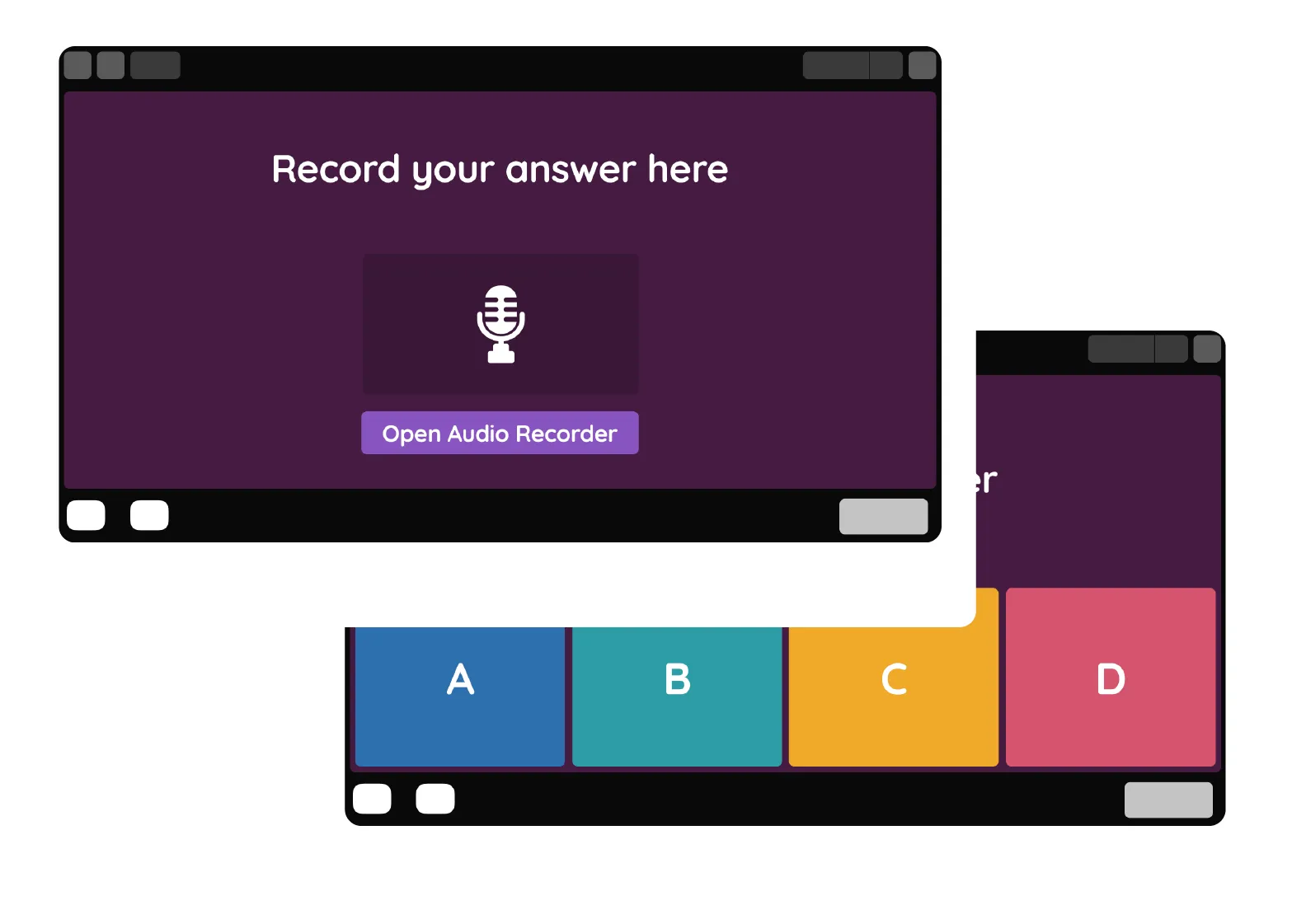
Craft homework using multiple question types
In this classic activity, learners can complete sentences by filling in the blanks with the right answers.
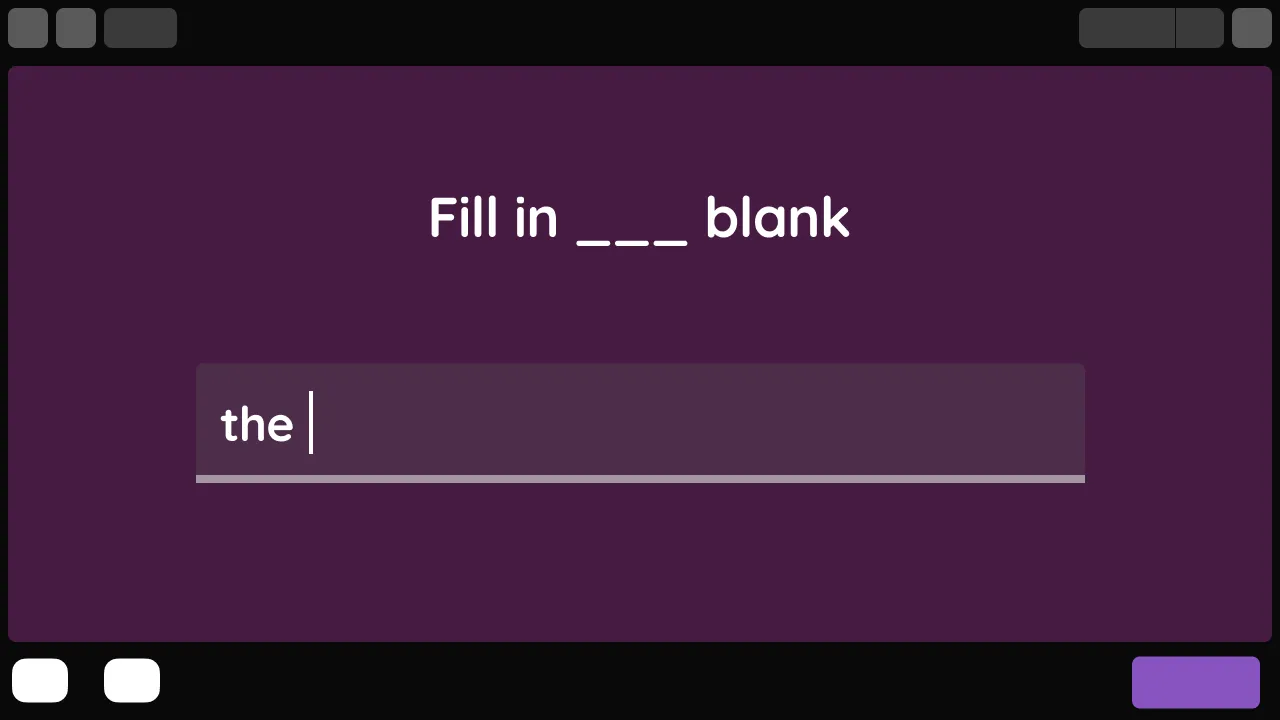
Ask your students to reorder a set of jumbled options in ascending, descending, or chronological order.
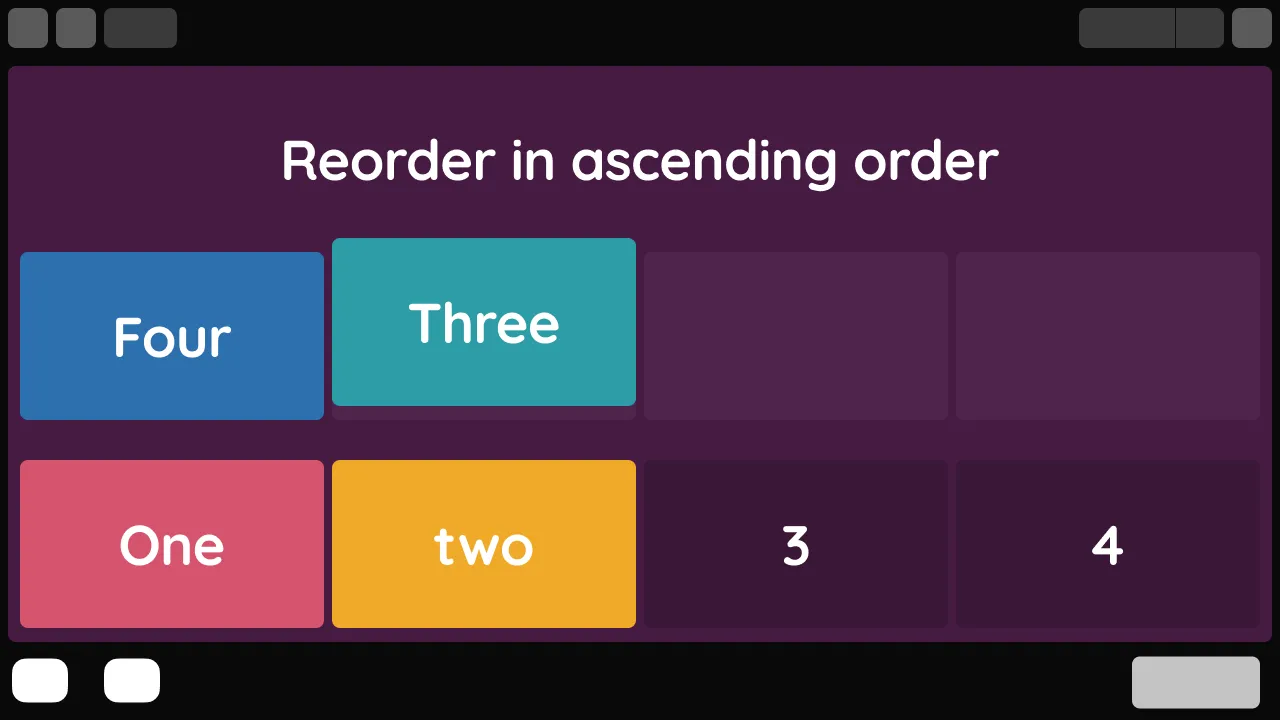
Present learners with the opportunity to select one or more correct answers from a list of options.
.webp)
Gamify your assessment with shuffled text and images that your students can pair together.

Choose between a plain background or an image and watch as students give shape to their thoughts with colors, highlighters, and more.
.webp)
Motivate learners to think critically by dragging and dropping the right options to complete a sentence.

Let students take center stage with video responses so you can assess their presentation skills.
.webp)
Check the pulse of your classroom with a fun poll or vote.
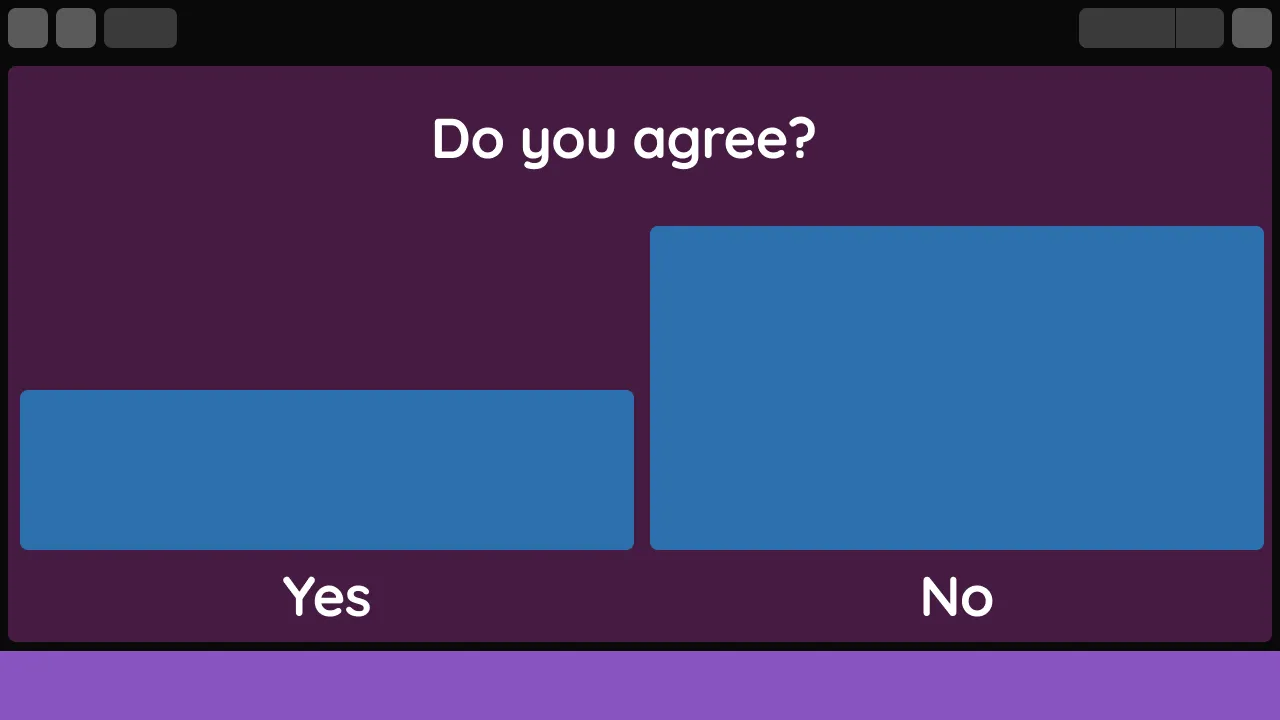
Use Lessons to create an instructor-led experience where slides and multimedia are combined with quiz and poll questions.
.webp)
Engage your students’ higher order thinking skills and encourage them to dig deep with open-ended questions.
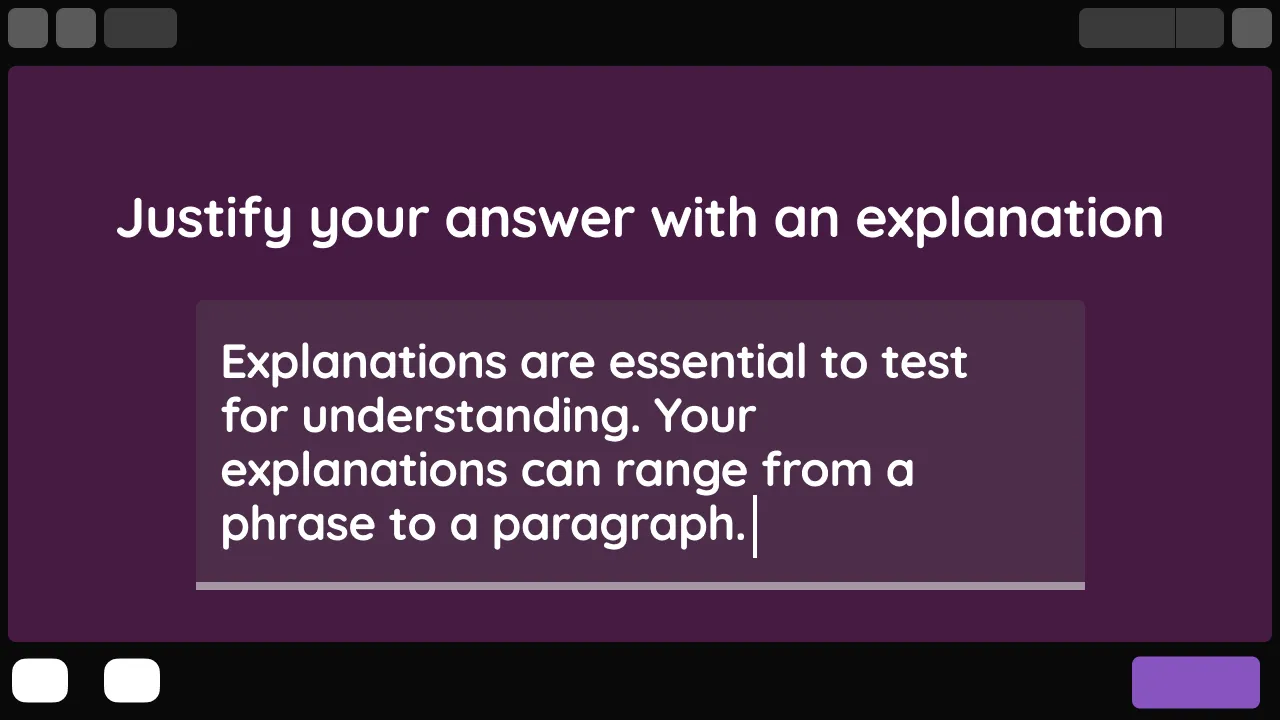
Analyze speaking skills by allowing students to voice their answers using the audio response feature.
.webp)
Prompt your students to choose between a set of drop-down options to fill out the blanks in a piece of text.
.webp)
With online homework on Quizizz you can
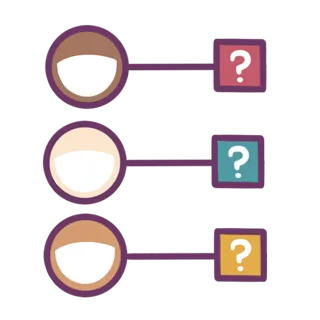
Grade flexibly
Allow Quizizz to grade homework assignments automatically. Or, assess submissions manually by assigning a scaled grade for each question.

Get instant reports
With detailed reports on Quizizz, measure the growth and progress of your students, and share significant milestones with other stakeholders.

Sync with an LMS
Update online homework and grades in the blink of an eye by syncing Quizizz with an LMS like Canvas, Schoology, or Google Classroom.
The best way to ask questions, explore ideas, and let students show what they know.
Use Quizizz for online homework


6 Homework Apps to Help Keep You Organized

Managing everything you have to do as a student can seem like a full-time job. With so many classes, activities, club meetings, and homework assignments thrown at you every day, it can be very overwhelming to keep track of it all.
Luckily, there are some great homework apps you can install on your phone or tablet that can help you know what classes you have coming up each day and stay on top of all of your assignments.
Here are six of our favorites. We hope these help you stay organized all year long!
Although the myHomework app supports traditional school schedules as well as block schedules, it does not support alternating block schedules, so if you have an A/B schedule, this is probably not the app for you.
- My Study Life This app is a full-fledged homework management app with its own web application, which is awesome because you can check your assignments from your computer or your phone. Plus, the calendar view shows all of your classes and assignments at the same time, and it shows you incomplete tasks that are due soon so you know what to work on first. The design is unique, too, with circles showing what percentage of a task is completed and how much more you have to go. Available for: iPhone, Android, Windows 8, Windows Phone and the web. Requires iOS 8.0 or later. Cost: Free
Another cool feature is that you can organize all of your assignments by date, course or priority, and you can sort them by pending and completed as well. Other bonus features include the ability to add contact info for all of your teachers and the ability to enter your grades so you can track how your GPA is doing.
Unfortunately, none of the apps listed above will actually do your homework for you — that part’s still up to you — but at least they’ll make it more likely that you’ll get it finished on-time and stress-free.
The organization was established over 50 years ago and works “to change the trajectory of high-potential Black youth by providing unique programming in the classroom and beyond.” Their scholars complete a four-year fellowship that includes academic enrichment, leadership development, career exposure, mentoring and college access.
Students must maintain a grade point average near 3.0 to remain in good standing with the organization — a bar the organization sets knowing full well that access to scholarships and grants for college will be the only way that most of its students can afford to go. Not all students meet this threshold despite mentoring from caring adults and strong support from administrative staff. Thus additional academic supports are needed.
Over many years, EE provided programs to help get students back on track if they started to flounder and to establish academic habits that put them on a trajectory for success. We started by offering weekly group tutoring events at the organization’s facility that not only helped students with homework completion and exam prep but also provided lessons on learning strategies, goal setting, and self-advocacy. However, traveling to the facility after school was a burden for some scholars, so EE tutors also met students at libraries and other public locations to provide support in specific subject areas where students requested help. Year after year we met with administrators and added additional resources: a summer school study skills workshop for freshmen and final exam prep workshops for all grade levels. Our unique array of programs allowed the organization to support their scholars at every stage of their academic journey.
The mission of the organization is to fight for economic mobility among highly motivated, first-generation college students by providing mentoring and intensive career development. The agency was founded on the belief that socioeconomic status should not be a barrier to college persistence and career success.
Their staff found that many of their participants were struggling with writing assignments of all sorts in college. From essays in English class to writing cover letters for potential summer internships, many students were not effective writers. The organization provided various career development workshops throughout the academic year, but they lacked a writer’s workshop to specifically address this area of weakness.
We met with program managers and the executive director to discuss their students’ needs and what type of program would be beneficial. The Writer’s Practice Workshop was an ideal fit for them. The course allowed students to understand that everyone is a writer even if they don’t think of themselves as such. Over the course of four sessions students assessed their own writing process; discussed the tools of a good writer’s practice; considered the audience, purpose, and the needs of any piece; and produced writing on topics that were important to them. Students left the workshop with a greater understanding of how to start assignments and follow steps to revise, edit, and polish for best results, giving them confidence in their writing.
The organization’s mission is to provide opportunities for underserved youth to achieve academic and personal success via financial, educational and personal support during their high school years. They provide tuition assistance to attend a high-quality school along with the guidance and commitment of caring, adult mentors. They aim to serve an often overlooked segment: academically “average” students from the city’s most challenging and underserved neighborhoods.
Program staff wanted to help their students prepare for final exams and train mentors to more effectively support students in their exam prep efforts. Volunteer mentors were available to give support, but the organization lacked a consistent approach on how best to help students and make them better learners.
EE met with program administrators and board members to plan and implement a Final Exams Workshop in the lead-up to final exams. The 3-hour workshop was attended by students and their mentors on a Saturday morning. The curriculum helped students create DIY study guides for any class, plan a study schedule, prioritize final exams by difficulty and need, assess and discuss their strengths and weaknesses in regards to learning strategies, and share with peers their successes or concerns. We also facilitated a conversation between mentors and mentees as to how they could best support their students in the coming weeks. Students and mentors left the workshop with a blueprint for attacking finals week in the most efficient way — a plan they could use for high school and college.
The organization supported immigrants and their families by connecting women from over 60 countries who share a dedication to the pursuit of global understanding and universal human rights. As part of their philanthropic arm, the organization supported a local elementary school they had identified as highly diverse with a large number of immigrant students. Before engaging EE, the organization relied mostly on volunteers to provide reading support to students during school hours.
After discussions with the organization and the school principal, teachers, families, and other stakeholders, we developed a school year calendar of after school programs that would help students develop the skills needed to succeed in elementary school and beyond. We provided courses for grades 5-8 in the spring and fall, greatly expanding the enrichment opportunities the NFP was able to provide. In doing so, we developed a close relationship with the school administration and their teaching staff, who saw the positive impact the program was having on their students. Additionally, the NFP was able to expand their mission to areas where they saw a great need: improving study skills, raising test scores, and increasing access to high school opportunities for immigrant youth.
A scholarship foundation funded by a suburban country club was disappointed with the caliber of student who typically applied for their college scholarship offerings. Knowing that the skills needed for success in college must be cultivated from an early age, they wanted to establish a summer enrichment program for students entering 9th and 10th grade that would serve as an early intervention and better position the pool of applicants when the time came a few years later to apply for the college scholarships.
We collaborated with the foundation to identify areas of strength and weakness in their applicant pool and listened to their personal beliefs about what it takes to succeed in college. With that understanding, we customized a version of the Summer Learners’ Workshop that lays the foundation for college-level skills and caters to the learning styles and academic backgrounds of the particular students at this organization.
The resulting program has gained a reputation as one of the top summer enrichment experiences in that community with parents routinely reporting that the results exceeded their expectations. The program is now attended by an even wider array of students than those who were first targeted by the foundation.
A charter school network was seeking to implement a test prep program across eight campuses to prepare their 8th grade students for the Chicago Public Schools selective enrollment entrance exam. The high school admissions process is highly competitive, and it was the middle of the Covid-19 pandemic when students were learning from home. The schools did not have expert knowledge about the contents of the test, and finding staff at their schools to cover a program outside of school hours would be challenging. Administrators knew how competitive the admissions process was and that even their strongest students were not guaranteed a spot. For equity, they wanted to offer the course to all of their students – even those who were very unlikely to be admitted to a selective enrollment school.
Given the wide array of students, the EE team worked with individual school counselors to create ability groupings, determine a process for reporting attendance, progress, and behavior issues, and create a curriculum that would be effective in a remote learning model. We knew that remote engagement for an after school program would be a challenge, so we incorporated competitive team games, a leaderboard of accomplishments, and other incentives to encourage maximum participation. EE provided all management and instructional staffing to deliver the test prep course successfully while freeing up teachers and counselors at the charter school to focus on their daily workload. Students received a robust course focused on strategies, practice tests, and concept review that put them in the best position to maximize their potential on test day.
A leading scholarship fund that provides financial assistance for highly qualified, low-income students knew that financial aid alone would be insufficient to ensure their students’ success at rigorous private and parochial high schools. Therefore, they sought an intensive summer program to prepare scholars for what lay ahead.
EE worked with the organization to determine the biggest challenges scholars would face. We landed on a wide array of non-cognitive skills that are not necessarily taught in middle school: time management, organization, self-advocacy, focus, growth mindset, etc. Inspired by this challenge, we developed our Ideal Student Workshop, which would later become the basis for our Learners’ Workshop.
Over a decade later we are still delivering the program to students at this scholarship fund and others. The program works to develop the three dimensions of successful students: character, learning strategies and habits. We update the program yearly to keep up with changes in student needs and the educational landscape. Our fun and research-based curriculum continues to be a popular summer bridge for various organizations.
A prominent sports-based youth development organization wanted to improve one of the core elements of their program: providing educational enrichment programs to their participants.
Their goal was to offer a continuum of services for 9th-12th graders that would support students in their schoolwork, provide a pathway to college, and create a culture of learning amongst players. EE was uniquely positioned to offer a variety of services to meet this need: private tutoring, study skills classes, writing courses, high school admissions test prep, SAT/ACT prep, and college readiness seminars. We listened to the players, parents, and other stakeholders to determine which programs were most effective, established expectations for participants, and decided on the best timing and format to deliver the courses.
Since 2017 we have successfully delivered these services allowing their administrative team to focus on their primary coaching responsibilities. Ultimately, the best praise we have received is that we have provided a wide circle of caring adults to support students academically and emotionally and that we have listened to their needs and adapted our offerings to suit their participants.
Suggested companies
My assignment help, all assignment help uae, top remote talent.

Myassignmenthelp Reviews
In the Educational Consultant category
Visit this website
Company activity See all

Write a review
Reviews 3.7.
Most relevant
I recently used Myassignmenthelp for…
I recently used Myassignmenthelp for assistance with my academic assignments, and I was thoroughly impressed with the service they provided. From start to finish, the experience was smooth and efficient. Pros: Timely Delivery: Myassignmenthelp ensured that all my assignments were delivered well before the deadlines. This reliability eased a significant amount of stress during busy academic periods. Quality of Work: The quality of the assignments was impressive. The content was well-researched, and it demonstrated a deep understanding of the subject matter. Communication: Communication with the support team was prompt and helpful. They were responsive to my queries and provided clear and concise information. Professional Writers: It was evident that the assignments were crafted by knowledgeable and experienced writers. The writing style matched the academic level, and the content was coherent and well-structured. Affordability: The pricing was reasonable, considering the quality of the service provided. Myassignmenthelp offers a good balance between quality and cost.
Date of experience : November 15, 2023
for Education
- Google Classroom
- Google Workspace Admin
- Google Cloud
Easily distribute, analyze, and grade student work with Assignments for your LMS
Assignments is an application for your learning management system (LMS). It helps educators save time grading and guides students to turn in their best work with originality reports — all through the collaborative power of Google Workspace for Education.
- Get started
- Explore originality reports
Bring your favorite tools together within your LMS
Make Google Docs and Google Drive compatible with your LMS
Simplify assignment management with user-friendly Google Workspace productivity tools
Built with the latest Learning Tools Interoperability (LTI) standards for robust security and easy installation in your LMS
Save time distributing and grading classwork
Distribute personalized copies of Google Drive templates and worksheets to students
Grade consistently and transparently with rubrics integrated into student work
Add rich feedback faster using the customizable comment bank
Examine student work to ensure authenticity
Compare student work against hundreds of billions of web pages and over 40 million books with originality reports
Make student-to-student comparisons on your domain-owned repository of past submissions when you sign up for the Teaching and Learning Upgrade or Google Workspace for Education Plus
Allow students to scan their own work for recommended citations up to three times
Trust in high security standards
Protect student privacy — data is owned and managed solely by you and your students
Provide an ad-free experience for all your users
Compatible with LTI version 1.1 or higher and meets rigorous compliance standards
Product demos
Experience google workspace for education in action. explore premium features in detail via step-by-step demos to get a feel for how they work in the classroom..
“Assignments enable faculty to save time on the mundane parts of grading and...spend more time on providing more personalized and relevant feedback to students.” Benjamin Hommerding , Technology Innovationist, St. Norbert College
Classroom users get the best of Assignments built-in
Find all of the same features of Assignments in your existing Classroom environment
- Learn more about Classroom
Explore resources to get up and running
Discover helpful resources to get up to speed on using Assignments and find answers to commonly asked questions.
- Visit Help Center
Get a quick overview of Assignments to help Educators learn how they can use it in their classrooms.
- Download overview
Get started guide
Start using Assignments in your courses with this step-by-step guide for instructors.
- Download guide
Teacher Center Assignments resources
Find educator tools and resources to get started with Assignments.
- Visit Teacher Center
How to use Assignments within your LMS
Watch this brief video on how Educators can use Assignments.
- Watch video
Turn on Assignments in your LMS
Contact your institution’s administrator to turn on Assignments within your LMS.
- Admin setup
Explore a suite of tools for your classroom with Google Workspace for Education
You're now viewing content for a different region..
For content more relevant to your region, we suggest:
Sign up here for updates, insights, resources, and more.
Celebrating 25 Years
- Join ADDitude
- |

- What Is ADHD?
- The ADHD Brain
- ADHD Symptoms
- ADHD in Children
- ADHD in Adults
- ADHD in Women
- Find ADHD Specialists
- New! Symptom Checker
- ADHD Symptom Tests
- All Symptom Tests
- More in Mental Health
- Medication Reviews
- ADHD Medications
- Natural Remedies
- ADHD Therapies
- Managing Treatment
- Treating Your Child
- Behavior & Discipline
- School & Learning
- Teens with ADHD
- Positive Parenting
- Schedules & Routines
- Organizing Your Child
- Health & Nutrition
- More on ADHD Parenting
- Do I Have ADD?
- Getting Things Done
- Relationships
- Time & Productivity
- Organization
- Health & Nutrition
- More for ADHD Adults
- Free Webinars
- Free Downloads
- ADHD Videos
- ADHD Directory
- eBooks + More
- Newsletters
- Guest Blogs
- News & Research
- For Clinicians
- For Educators
- Manage My Subscription
- Get Back Issues
- Digital Magazine
- Gift Subscription
- Renew My Subscription
- ADHD Parenting
Turning It In Should Be the Easy Part of Homework, Right?
Even when they complete their homework, students with adhd don’t always remember to turn in assignments on time — or at all. help your kid get credit for all her hard work by setting up these fool-proof organization systems at school and home..

The problem: The student with attention deficit disorder (ADHD or ADD) consistently neglects turning in homework or long-term projects, even though she claims to have completed the work.
The reason: Children with ADHD have difficulty keeping track of bits of information and paperwork. This problem is likely related to underactive frontal lobes — the area of the brain that controls memory and processing. It’s because of this difference in brain activity that children with ADHD have a hard time focusing on more than one thing at a time.
The obstacles: Children with ADHD often want to complete their work and turn it in on time, but often lack the organizational skills or the memory capacity of other youngsters their age. These students may forget something that just happened as their focus shifts from one task to another or from one class to another. When completing an assignment, for example, students have to work their way through many tasks — including listening to and recording what needs to be done, doing the assignment, and turning it in. It’s very easy for children with ADHD to get interrupted along the way and forget where they are in the process.
Parents and teachers will often find this ADHD behavior puzzling because we assume that, if someone can do something one day, they should have the skill to do it the next day. But mental disorganization causes these children to be inconsistent, leading adults to believe the lapse is intentional. When teachers respond by giving zeroes or bad grades, it only discourages the child and doesn’t solve the problem.
Solutions in the Classroom
Children with ADHD need a high degree of supervision and structure in the classroom. A monitoring system that provides students with cues and reminders can help.
[ Free Parenting Resource: Solve Your Child’s Homework Problems ]
- Provide copies of assignments. Give students written copies of homework assignments whenever possible. This will ensure they have the complete assignment.
- Have parents sign off. Create a homework assignment sheet that must be initialed by both the parent and teacher for oversight and support.
- Break up big assignments. For long-term assignments, plan to track the child’s progress at different points in the process rather than only at the end.
- Create a homework folder. Designate a folder that your child keeps in his binder to help him remember to bring finished homework back to school. Use it as a receptacle for all assignments once they are finished.
- Give feedback. Correct and return the child’s homework as soon as possible. Corrections should be positive and instructive.
- Discuss accommodations. Talk to the child and parent about the accommodations and supports they think might help. No one plan is effective for all students.
[ Free Webinar Replay: Stress-Free Homework: Tips, Tools, and Solutions to Lower the Household Stress Level ]
Solutions at Home
Children with ADHD need parents to help them set up a system to get from the beginning of a project to the end.
- Organize tasks. Help your child create a checklist of required tasks to help her keep track of where she is in the assignment process. Make copies of the checklist to keep in her binder and post in her room.
- Label and color-code books, binders, and folders. All subjects should use the same color to keep paperwork organized .
- Establish routines. Set up a routine specifically for getting assignments back to the teacher (for example, as soon as it’s finished, it goes into a folder next to the front door).
- Don’t let your child procrastinate. He will likely need your help to get started on a task and see it through.
Some children desire more independence. Tell yours that she can earn the right to monitor her own work after demonstrating success for a few weeks.
[ 9 Secrets to a Super Effective School Planner ]
Homework & Studying: Read These Next

9 Things I Wish the World Knew About My Students’ ADHD

A Teacher’s Guide to NVLD: How to Support Students with Nonverbal Learning Disability

ADDitude's Top 10 Webinars of 2022

Your Executive Functions Are Weak. Here’s Why.
Adhd newsletter, success @ school, strategies for homework, accommodations, ieps, working with school & more..
It appears JavaScript is disabled in your browser. Please enable JavaScript and refresh the page in order to complete this form.

Get school assignment help with Windows 11
Whatever type of schooling you’re doing, several key Windows features can help improve your skills and assignments. Learn how to capture thoughts more quickly, hone presentation skills, get math help, do two things at once, and more with Windows 11 .
First-time users of the Dictate feature will be asked to give permission for Word to use the microphone, after which talking and transcribing can begin. Thoughts can be recorded with focus kept intact and productivity preserved. Word will do its best to transcribe everything with capitalization and punctuation. This is especially helpful for kids who have dyslexia, dysgraphia, or who have trouble reading or writing.
Share this page
Capture thoughts more quickly
Most people can talk faster than they can type. Save time and collect your ideas more quickly with Dictate, the speech-to-text feature in Microsoft Word.
First-time users of the Dictate feature will be asked to give permission for Word to access the microphone. Once permission is granted, click the microphone icon to begin. Word will do its best to transcribe everything with capitalization and punctuation. Your thoughts can flow as you speak your ideas to the page. This may be particularly useful for anyone with dyslexia, dysgraphia, or who has trouble reading or writing.

Make it easier to start writing
Get coached on presentation skills.
Most students dread being assigned a presentation, but luckily, Windows can help sharpen both content and delivery. Practicing presentations while looking into a mirror is a long-standing tradition, but at best it can help you with eye contact and facial expressions. You can get more impactful guidance on your presentation skills with Presenter Coach in PowerPoint. If you give permission to use your computer’s microphone, it can analyze a speech or presentation.
Presenter Coach looks out for all of the following::
- Pacing (words per minute)
- Usage of fillers, like ums, ers, uhs, you knows, etc.
- Informal speech
- Euphemisms and culturally sensitive terms
For example, if you say the phrase, “best man for the job,” Presenter Coach will suggest “best choice for the job” to use more inclusive language.

Prepare in private to give more effective presentations
Improve reading comprehension.
Ever read a large block of single-spaced, tiny-sized text and not comprehended a word of it? Immersive Reader can help with that and even provide extra help to anyone learning to read.
Immersive Reader takes text and increases the sizes of the letters and spacing between lines, while simultaneously enabling it to be read aloud in voice. As it reads the passage, it highlights each word as it’s spoken. At any time, you can change the reading speed, font, or background color, and you can even highlight which words are nouns, adjectives, or verbs.
This powerful tool can also translate words or entire documents into 67 languages. It’s an excellent tool for homework assignment help. Immersive Reader is included in Word, Outlook for the web, OneNote, Teams, Flipgrid, Forms, Microsoft Edge, Minecraft, Whiteboard, and Office Lens.

Redefine the way you read
Multiply your abilities with math help
Math Assistant is a digital tutor that helps with difficult math problems. Write or type math problems in OneNote, and Math Assistant can solve it for you—helping you reach the solution quickly or displaying step-by-step instructions so you learn how to reach the correct answer on your own.
Say you are faced with a problem in your textbook with an ask like “solve for x.” Where would you start?
With Math Assistant in OneNote, you could start by sketching out the problem with the draw tool. After solving, you can even have Immersive Reader read steps aloud and generate quizzes for additional practice to help you learn the concepts, not just get the assignment done.
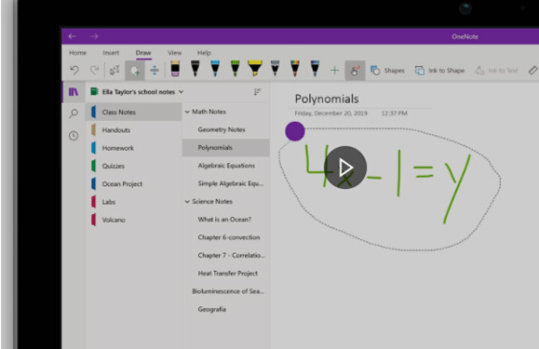
Learn how to solve math equations
See what you need on screen, side-by-side.
Flipping back and forth between windows wastes time, but we’ve all done it. It could be that your class is streaming in your browser, and you’re taking notes in OneNote or “passing notes” in Teams or Skype. Maybe your reference material is on a web page, and you’re answering questions in another app. If you’re still flipping back and forth between the different apps and windows, prepare to be delighted by Snap.

Use Snap to see two things at once
With these Windows 11 features to help with your homework assignments, you can increase productivity and maximize academic success.
More articles

4 ways to get a PC ready for the new school year
Get some tips to best prepare for remote, distance, or hybrid learning by preparing the must-have apps for successful students.

4 ways to help keep your student safer
Learn easy safeguards you can put it in place to help protect from unseen threats online, while helping your kids become more independent.

3 reasons to consider getting a new computer
Is your computer keeping up with everything you've been trying to do for the last few months? Get tips on what to look for to get the speed, price, style and more that works for you.
Find help for school questions. homework projects assignments
Ask a question below to start receiving help, only expert tutors, all subjects covered, full privacy options, ask any type of question, pay what you can afford, money back guarantee, as mentioned on.

The Number One Site in the World for Online Tutoring since 2014
Have the best tutors in the world teach and guide you through difficult questions, essays, assignments..
Trusted and Recommended by Thousands of Students
@schoolsolver Thanks to you I was able to get a review guide done for my math final — Jessicabobessica (@jessicaloser77) February 1, 2016
Stop wasting time trying to find help on other homework sites or even chegg. @schoolsolver is where its at. — Lucy Barnard (@lucybarnard7) December 29, 2015
@schoolsolver thanks for create this best homework answers site — Akhilesh Singh (@akhilesh_singh) July 31, 2020
@schoolsolver is definitely a valuable service as the marketplace for online homework — JOY (@mdjoy07) December 29, 2015
GOD SCHOOL SOLVER HAS BEEN SUCH A HELP FOR ME. DONT THINK I WOULD HAVE PASSED W/O IT — SamuelGrant (@GdinSamuel) July 1, 2016
@schoolsolver is the easiest way to get your doubts solved. The interface is intuitive to understand and process simple to comprehend, for both tutors and students. The bidding process matches supply and demand, cutting all the redundant red tape. — neel shah (@Neel_dude99) June 10, 2020
https://t.co/LUFoeGM0KE is overpriced and not helpful. https://t.co/0uy3xFmmez is where I go — File Filey (@FileFiley) November 26, 2018
SchoolSolver Review: Excellent Way To Earn By Doing Assignments https://t.co/s2Yl8pCQFh #freelancemoneymaking — Bihog (@FlyingBihog) July 20, 2019
Wow Surprised at how easy it was to use @schoolsolver for my homework questions. Literally one day later had it all done. — Enes Oglic (@chupatore) July 1, 2016
@schoolsolver - thank you for not making me have to deal with shady online tutors anymore — Jaja Cherin (@jajacherin) July 1, 2016
https://t.co/HMAjxnA9sJ is the site to use for homework answers — amiku amku (@amikumku) July 1, 2016
I love you @schoolsolver . I just wish i had used your service earlier. Like back in middle school :p — LeslieBrandon7X (@LeslieBrandon7X) November 26, 2018
Made 1200 bucks last month with @schoolsolver alone. Keep the questions coming babby — Mahesh (@mrmaheshr012) November 30, 2018
if i had @schoolsolver back when I was in high school i would have been 1000x more efficient? — AlyssaGregoirey (@ErwinBaselpa7M) November 27, 2018
Latest Answered Questions
Top earners.

expertsolution

Phd_Level_Writerr

tutormaster

Uploading copyrighted material and cheating is not allowed. Refer to our DMCA policy in our TOS for more information.
For Earth Day, Try These Green Classroom Activities (Downloadable)
- Share article
Earth Day is April 22 in the United States and the day the spring equinox occurs in some parts of the world. It’s a day to reflect on the work being done to raise awareness of climate change and the need to protect natural resources for future generations. Protecting the earth can feel like an enormous, distant undertaking to young people. To help them understand that they can play a role by focusing on their backyards or school yards, educators can scale those feelings of enormity to manageable activities that make a difference.
We collected simple ideas for teachers and students to educate, empower, and build a connection with nature so that they may be inspired to respect it and protect it. Classrooms can be the perfect greenhouse to grow future stewards of the environment.
Click to Download the Activities

Sign Up for EdWeek Update
Edweek top school jobs.

Sign Up & Sign In

Global site navigation
- Celebrities
- Celebrity biographies
- Messages - Wishes - Quotes
- TV-shows and movies
- Fashion and style
- Capital Market
- Family and Relationships
Local editions
- Legit Nigeria News
- Legit Hausa News
- Legit Spanish News
- Legit French News
"I Have Swallowed My Pride": Man Begs Nigerians to Help Solve Difficult Assignment Given to Cousin
- A Nigerian man has pleaded with his followers to help him solve the assignment which was given to his little cousin
- The young man who badly wanted to retain his big uncle status pleaded with Nigerians for immediate assistance
- While some netizens provided answers to the problem, others insisted that the question was above primary school pupils
PAY ATTENTION: The 2024 Business Leaders Awards Present Entrepreneurs that Change Nigeria for the Better. Check out their Stories!
A Nigerian man has begged netizens to help him retain his ‘big uncle’ status after his little cousin came home with a difficult assignment on Quantitative reasoning.
He shared a photo of the assignment book and pleaded with netizens to teach him how to solve the questions .

Man displays cousin's tough assignment
The man identified as @ Deputyzaddy on X stated that he had to swallow his pride to ask netizens for help.

Nigerian lady devastated as boyfriend flees with her N10 million business money, video stirs emotions
PAY ATTENTION: Follow us on Instagram - get the most important news directly in your favourite app!
He asked people to either teach him how to solve the problems or solve it themselves and reveal the answers.
He further reiterated his strong decision to marry a brilliant woman who knows how to solve mathematics questions.
“Please I need help. I've swallowed my pride. Someone help me solve this or teach me how to solve this. I need to retain my Big Uncle Status. Just number 1 to 6. Please.
"I'm trying to help my little cousin solve her quantitative reasoning assignments and believe me l have resolved to marry an arithmetic inclined lady.”
Reactions as man displays tough assignment
Some netizens helped him solve the problem while others insisted the arithmetic was above primary school pupils.
@dubemkodi reacted:

“One year in UK, bought a laptop, iPhone and car”: Nigerian man shares his experience
“That's permutations and combinations. They are starting early with them.”
@ifenyinwa_ said:
“I think the numbers stops multiplying when the denominator gets to 1.”
@Akanji_ reacted:
“Chai dem dey use style style introduce permutations and combination to this kids through quantitative reasoning.”
@Iam_themmie reacted:
“It's permutation. Multiply downwards until it gets to 1. You can check the topic on YouTube.”
@Coyg said:
“Societal influence is good o. No be to de do Gen Z upandan again. I think I learnt factorial from ss1. How will you now put it in quantitative reasoning for primary school? This school means business.”
See the post below:
Little boy closes assignment book in video
Meanwhile, Legit.ng previously reported that a mother was helping her son do his assignment when the little boy suddenly closed the book and stood up.
In a hilarious video, the boy walked out without turning back. His mother captured the moment on camera.
PAY ATTENTION: Unlock the best of Legit.ng on Pinterest! Subscribe now and get your daily inspiration!
Source: Legit.ng

IMAGES
VIDEO
COMMENTS
Best Paid Homework Help Site: Chegg. Price: $14.95 to $19.95 per month. Best for: 24/7 homework assistance. This service has three main parts. The first is Chegg Study, which includes textbook solutions, Q&A with subject experts, flashcards, video explanations, a math solver, and writing help.
Get all your assignments done with helpful answers in 10 seconds or less. ... StudyMonkey is your new smart bestie that will never ghost you. No more staying after school. AI tutoring is available 24/7, on-demand when you need it most. AI Tutor for any subject ... Receive step-by-step guidance & homework help for any homework problem & any ...
Students looking for help with assignment writing in school, college, or university can't really splurge on such online writing services. ... Will My Assignment Help Do My Assignments for All Genres? MyAssignmentHelp is the #1 service provider in the US that makes the learning process easier with high-quality assignments. The writers use their ...
Best Paid Homework Help App: Brainly. Price: $18 for a 6 month subscription, $24 for a year. Best for: 24/7 homework assistance. Brainly is free to download and allows you to type in questions (or snap a pic) and get answers and explanations from both fellow students and teachers.
The Best Assignment Help Websites for College Students. 1. AssignmentBro. Company's History. This friendly company belongs to relatively new offerings, yet they have already earned the hearts and minds of school and college students worldwide.
Simply put, the goal is to get your homework done quickly and still make a good grade on the assignment! Here are our two bonus tips for getting a decent grade on your homework assignments, even when you're in a time crunch. #1: Do the Easy Parts First . This is especially true if you're working on a handout with multiple questions.
Trusted Online Assignment Help Website. GradeHood is one of the best assignment writing websites for high school, college, and university students! Our online assignment helps services connect you with experienced assignment helpers who can assist with your academic needs. Whether you need someone to "do my assignment" or require help with your ...
4. Power Planner. Power Planner is a clean and simple study schedule app that's perfect for middle school, high school, and even college students. As one of the most useful apps for every student, it helps you remember class times, keep track of tests, and can assist you with staying on top of your assignments.
The ultimate study app. The MyStudyLife student planner helps you keep track of all your classes, tasks, assignments and exams - anywhere, on any device. Whether you're in middle school, high school or college MyStudyLife's online school agenda will organize your school life for you for less stress, more productivity, and ultimately ...
Essay writing process. The writing process of preparation, writing, and revisions applies to every essay or paper, but the time and effort spent on each stage depends on the type of essay.. For example, if you've been assigned a five-paragraph expository essay for a high school class, you'll probably spend the most time on the writing stage; for a college-level argumentative essay, on the ...
What this handout is about. The first step in any successful college writing venture is reading the assignment. While this sounds like a simple task, it can be a tough one. This handout will help you unravel your assignment and begin to craft an effective response. Much of the following advice will involve translating typical assignment terms ...
Tip #2: Divide a Homework Assignment into Manageable Tasks. Break your school assignment down into smaller tasks. Make a list of what needs to be done for that particular assignment, set priorities to focus on, and start at the top of your list. Many times, a written project will require some library research.
Instructors: Create, edit and delete courses and assignments. Create an assignment. Attach template files to an assignment. Create or reuse a rubric for an assignment. Turn on originality reports. How instructors and students share files. Add co-instructors. Set up Assignments in a Schoology course. Delete courses & assignments.
When you assign homework online, you can easily allocate and track assessments, quickly provide feedback, and tailor content to meet the specific needs of your students. As a teacher, making the shift from pen-and-paper homework to online homework can benefit both you and your students. Online homework platforms, such as Quizizz, offer a host ...
6. Power Planner. Android, iOS, and desktop: Free with paid upgrade available. Power Planner is a well-established student planner app with many of the same features as myHomework and iStudiez, like entering your schedule, keeping track of your GPA, and viewing assignments and exams. Source: Student-Tutor.
Requires iOS 8.0 or later. Cost: Free, $2.99 for in-app products. Chalkboard. The best time to write down your homework is right when it's assigned. That's why it's great that at the end of each class, Chalkboard displays a notification that lets you add your homework assignment quickly and easily.
Professional Writers: It was evident that the assignments were crafted by knowledgeable and experienced writers. The writing style matched the academic level, and the content was coherent and well-structured. Affordability: The pricing was reasonable, considering the quality of the service provided. Myassignmenthelp offers a good balance ...
Learn to Prioritize. After school, have a snack together and open the planner. Look over the list of homework assignments for that day, asking him to estimate how much time it will take to complete each one. Write the estimate next to each assignment. Then help him prioritize his work — math first, reading second, social studies third.
Easily distribute, analyze, and grade student work with Assignments for your LMS. Assignments is an application for your learning management system (LMS). It helps educators save time grading and guides students to turn in their best work with originality reports — all through the collaborative power of Google Workspace for Education. Get ...
Break up big assignments. For long-term assignments, plan to track the child's progress at different points in the process rather than only at the end. Create a homework folder. Designate a folder that your child keeps in his binder to help him remember to bring finished homework back to school.
Whatever type of schooling you're doing, several key Windows features can help improve your skills and assignments. Learn how to capture thoughts more quickly, hone presentation skills, get math help, do two things at once, and more with Windows 11. First-time users of the Dictate feature will be asked to give permission for Word to use the microphone, after which talking and transcribing ...
Keep the questions coming babby. if i had @schoolsolver back when I was in high school i would have been 1000x more efficient? School Solver is a marketplace for students to get help with homework questions, answers, and projects. It also provides a way for students and tutors to get paid and make money answering homework questions.
How to place an order to write my assignment for me. Step 1. If you have faced any academic problems and cannot perform the assigned task, this is the right spot because our company is always ready to come to the rescue! The first step requires you to register using contact email address and submit an order form for a paper.
Candles burn at a makeshift memorial near Columbine High School on April 27, 1999, for each of the of the 13 people killed during a shooting spree at the Littleton, Colo., school. Michael S. Green/AP
"I'm trying to help my little cousin solve her quantitative reasoning assignments and believe me l have resolved to marry an arithmetic inclined lady." Reactions as man displays tough assignment Some netizens helped him solve the problem while others insisted the arithmetic was above primary school pupils.